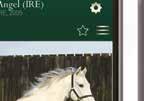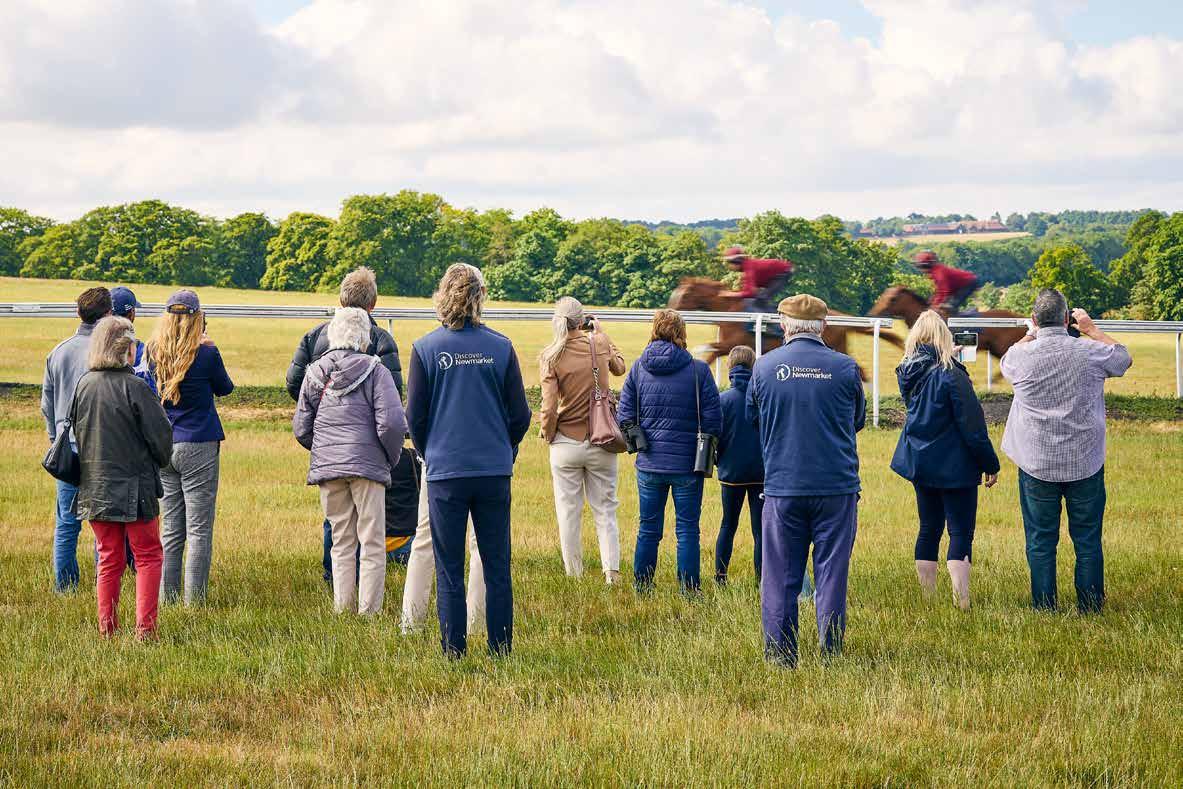

Field Of Gold reigns
A brilliant performance at Royal Ascot puts the son of Kingman at the top of the European three-year-olds ratings

Equine Art Edition featuring artist Terence Gilbert, publisher Jane Badger, and Crown Jewels Racing

The journey starts with you
Juddmonte would like to thank all those breeders from around the world who have supported our stallions in the 2025 breeding season.

BATED BREATH | CHALDEAN | FRANKEL | KINGMAN | OASIS DREAM
NO NAY NEVER JOINS HIS SIRE SCAT DADDY AT THE TOP…

CHARLES DARWIN clocked the second fastest Norfolk S. [Gr.2] time at Ascot ever. Second only to NO NAY NEVER!
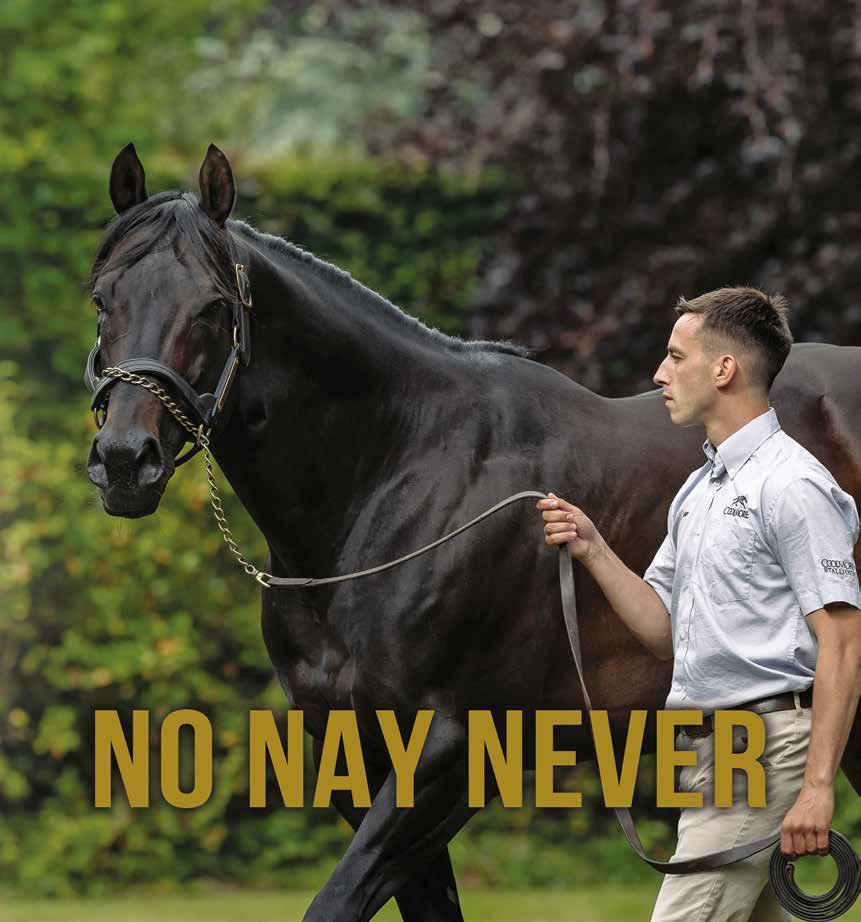
Sire
Despite Royal Ascot Day 1 wardrobe problems for Leo, our man enjoys a fabulous week of racing in Berkshire 14 Tales from the Ton
Cathy Grassick had an out-of-reality feeling at Royal Ascot – for a time she felt as though she was on the set of Bridgerton
Everyone’s a winner
There was Royal Ascot success for first-timers, smaller-scale yards, big teams, as well as stallions at all ends of the fee spectrum, writes Amy Bennett

56 What’s my age again?
Jocelyn de Moubray looks back on the Epsom Classics, which saw Australia show off his prowess as a middle-distance sire
32 Art form
Aidan O’Brien’s Classic dominance has crossed the English Channel –Ballydoyle winning both of this year’s colts’ Classics with sons of Wootton Bassett
36 Horses to follow
The team at Trackside marks our card with a selection of horses that have hit the text messaging service this summer
This year’s Triple Crown series saw Sovereignty and Journalism, the best two colts of their generation, close out the three races between them
Weatherbys Stallion Scene: Part 1
Toronado has enjoyed a top year in Australia – Adam Sangster of Swettenham Stud discusses standing Al Shaqab’s son of High Chaparral, as well as the organisation’s younger stallion Wooded
50 Weatherbys Stallion Scene: Part 1
First-season sire Vandeek is shuttling to Arrowfield Stud in Australia – we chat with the farm’s Jon Freyer and Cheveley Park Stud about plans
Dubawi and Walk In The Park finished second and third behind Motivator in the 2005 Epsom Derby, and both have gone on to enjoy champion sire glories
62 Diversity
Debbie Burt meets the hugely experienced artist Terence Gilbert and chats about his passion for art in an enduring career spanning nearly seven decades
68 Turning pony books into ebooks
Jane Badger is making the most of modern technology to revive older, well-loved, pony books that many of us (mainly girls) grew up reading
74 Jewel in the Crown
Seb Vance discusses the success story that is Crown Jewels Racing –a broadcasting joint venture between Racing TV and HBA Media showcasing 20 of the world’s best races
74 Fact-based nutrition
For the good of your horse ‘s development and to the financial benefit of your pocket, it is an idea to get your farm soil sampled, advises the ITBA
82 Photo finish
Going to post for the Epsom Derby



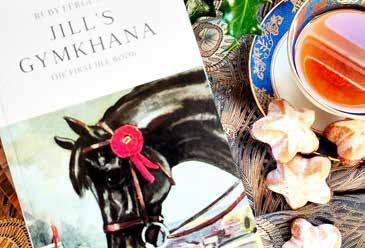
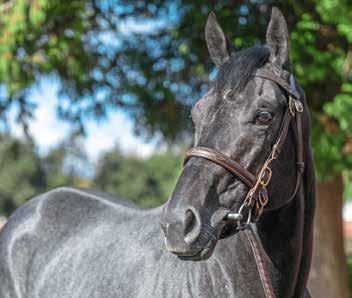

the team
editor sally duckett
publisher declan rickatson photography trevor jones design thoroughbred publishing
advertising declan rickatson 00 44 (0)7767 310381 declan.rickatson@btinternet.com
subscriptions tracey glaysher itsubs@btinternet.com
laura green goffs

Windsor’s Thames Hospice charity shop
comes to Leo’s Royal meeting Day 1 wardrobe rescue
Royal moments
MY FAVOURITE DAY OF RACING
in any year is Arc Sunday at ParisLongchamp, but my most treasured week of the sport is Royal Ascot. Five days of superb action, set against the backdrop of British tradition and ceremony, and with the chance to dress up!
I know many feel the wearing of top hats and tails is somewhat passé, but not me. I join in the chorus of those complaining about the heat, and the layers of clothing, but you will not find me calling for it to change. This is a showcase of our sport at its best, and a week that has the eyes of the racing world, in a global sense, trained on Berkshire.
Friends in Ireland, many of whom are only aware of Royal Ascot from the coverage it receives on the non-racing pages of daily newspapers, often quiz me about attending the meeting, curious if I indeed sport the full regalia. I do, with different coloured shirts, ties to be matched with a similar hued buttonhole, and five waistcoats. I fly the flag for Ireland with an Irish tweed waistcoat in a subtle cream tone.
Which brings me neatly to a near catastrophe on the opening day this year. Based in London for couple of nights to take in the Goffs London Sale, and a visit to my favourite barber in Paddington, I was doubly careful when setting out my attire for Tuesday on the previous night, just in case the after-effects of a couple of glasses of the Léoube Rosé on offer at Goffs had a negative effect on me. I was all set to go, with a stop near Ascot to change.
Horror of horrors. My waistcoat was nowhere to be seen!
Instead, it remained hanging in my hotel room wardrobe. No panic Leo. You are on the outskirts of
I first checked that it had a full set of buttons, and then looked at the back to ascertain if it could be ‘let out’ a bit to accommodate my tummy....
Windsor, have given yourself plenty of time to make the races, and a quick detour will sort the problem out. Can you imagine the state I was in when, almost an hour later and having visited every outlet that might have stocked a waistcoat, I failed to find one?
Could I go racing without one? I would surely attract the attention of the diligent dress code police –sorry assistants.
As I debated whether to return to London and perch myself in front of a television, a voice inside suggested
Leo looking smart in his “new” emergency-bought waistcoat
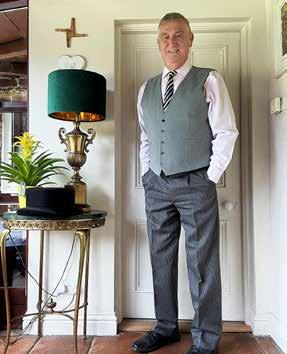

I try a vintage charity shop on Windsor’s high street, though the window display was all women’s clothes. A frown on the forehead of the shop assistant when I told her what I was looking for seemed to nudge me further in the direction of a trip back to London.
She pointed to a small rail of men’s clothes and, with a deepening sense of despair, I took a look. The first item on the rail was – unbelievably – a grey waistcoat, but it was too much to expect that it would fit a larger than usual me! I first checked that it had a full set of buttons, and then looked at the back to ascertain if it could be ‘let out’ a bit to accommodate my tummy. The answers were yes and no!
Apprehensively, given that there was no indication of a size on it, I tried it on. Slowly, I closed the front, and, hey presto, the buttons slid into the buttonholes. It did require a small intake of breath, but I could manage for one day.
Phew. I got to the till, paid the princely sum of £7.50 to the lady, and left her bewildered as I literally ran out of the shop. I did hear her, in vain, attempt to call me back for a receipt “in case you need to bring it back”. Thanks Thames Hospice – you saved the day!
Field Of Gold is a horse who is right up there with the best of recent years and his physique would suggest that he will be even better with time
Highlights of the week
In spite of all the pomp and circumstance that surrounds the meeting, it is the racing at Royal Ascot that takes centre-stage.
It can be the making of a future stallion, the coronation of a champion, and also the emergence of new talent, whether equine, training or riding.
I have so many highlights of the week that it would not be feasible to even try to include them all. Here are some, and in no particular order.
My racing top spot has to go to Field Of Gold on the opening day (just as well I didn’t return to London), who demolished high-class rivals to win the St James’s Palace Stakes.
Field Of Gold is a horse who is right up there with the best of recent years, and his physique would suggest that he will be even better with time.
Having seen Field Of Gold’s Classic win at The Curragh, and suffered with nerves throughout, the Kingman colt’s breeders decided to eschew a visit to Ascot, and instead watch the race at home.
With the knowledge that Field Of Gold’s dam Princess De Lune (Shamardal) is back in-foal to the
Field Of Gold: for Leo, and for many, the son of Kingman put in the best performance seen through Royal week
colt’s sire, Honora and Bobby Donworth were relieved and thrilled in equal measure to see him beat his 2,000 Guineas conqueror Ruling Court by 7l.
When trainer Harry Eustace saddled Docklands to win the opening Queen Anne Stakes, he must have thought that his week was made. Just his second Pattern winner since taking over from his father James in 2021, this was a dream result. Two years ago, Docklands had given Harry a Royal Ascot victory in the Britannia Stakes, and last year found just Charyn too good in the meeting’s opener.
Imagine what Harry’s heart-rate must have been when, three days later, he had a third Royal Ascot winner in his fledgling career, and another Group 1 success. This time it was with Time For Sandals in the Commonwealth Cup.
Four runners for the Newmarket handler also saw La Botte denied by a neck in the Britannia Stakes, while Divine Comedy was less than 2 behind Ascending when a close fifth in the Ascot Stakes –and she met traffic problems in the race.
Again, from the opening day, what a special moment for owner Chris Jones, trainer Henry de Bromhead, and jockey Billy Lee, to win the aforementioned Ascot Stakes with Ascending. He
Imagine what Harry’s heart-rate must have been when, three days later, he had a third Royal Ascot winner in his fledgling career, and another Group 1 success
beat a trio of Joseph O’Brien runners in a blanket finish after two and a half miles. The Jones colours, inherited from his dad, also Chris, have been carried to many famous NH wins, and I will forever link them with Klairon Davis.
Winner of the Queen Mother Champion Chase, Klairon Davis was trained by Arthur Moore, and it was his daughter Anna and husband Kevin Ross who bought Ascending for Chris.
I bumped into Chris at the Goffs London Sale with his sister Maeve O’Reilly, and they were just happy to have a runner at Royal Ascot. Somewhat surprisingly, he told me it was his first time to race at the meeting. He will surely make it an annual pilgrimage now!
As pleased as I was for Chris and Henry (who trains a chaser that I own a tail of), readers of my breeding columns will know of my undying love and admiration for Ascending’s sire, Awtaad.
Not only did Awtaad sire Ascending to win at the meeting, but he was among a very select group of stallions to double up, thanks to Ethical Diamond winning for Willie Mullins, the H O S Syndicate and Ryan Moore in the 1m4f Duke Of Edinburgh Stakes. Awtaad’s son Anmaat was a fine second at Royal Ascot in the 1m2f Group 1 Prince of Wales’s Stakes.



Ascending winning the Ascot Stakes for Chris Jones: his colours are well known in the NH field and Jones admitted that it was his first visit to the Royal meeting

Thank you
To all breeders who entrusted their mares to Aga Khan Studs stallions in 2025, and to all farm managers, stud staff, secretaries,


Is there a better value sire standing anywhere in Europe than Awtaad at €7,500?
The Group 1 victory for Time For Sandals pleased me no end because the three-year-old was bred by Joe and Jane Foley at their Ballyhane Stud, and is a daughter of Sands Of Mali who the Foleys stand at the Leighlinbridge farm.
Royal Ascot was good for the sire last year when his son and daughter, Ain’t Nobody and Aviation Time, ran second and third in the Listed Windsor Castle Stakes. Now the same venue has given him his first winner at the highest level. I predict that another daughter of Sands Of Mali will become a Group 1 filly – watch out for Copacabana Sands.
Finally, could the Irish National Stud Management Course be advertised as the best source of leading trainers, in addition to all of the industry personnel of note that it has produced?
Four years ago, to celebrate 50 years since Michael Osborne introduced the course, I featured a number of graduates who had either become household names in the business, or were an emerging talent. Harry Eustace was one, and Jérôme Reynier another.
At the time, I wrote: “Jérôme Reynier. Remember the name. This is a man going places.” He already had form, as they say, but his subsequent career has simply gotten better and better.
At Ascot the four-year-old Lazzat has run 11 times, was unraced at two, and his eighth victory in the 6f Group 1 Queen Elizabeth II Stakes was his second success at the top table. Last year he gave Reynier a second triumph in the Prix Maurice de Gheest. I have said it before, and will say it again. Jérôme Reynier. Remember the name.
A lot can happen in three months
It was mid-March when I last filed copy for this diary, and what a lot has happened since. Fairyhouse and Punchestown Festivals; a trip to Beirut which brought with it fine weather, great food, and a sad reminder of the perilous state of the last racecourse there; and a plethora of sales, classic races and Aintree.
I was lucky to again be a guest of Randox at the Grand National in Aintree. As with almost every renewal of the great race, the story behind the winner is extraordinary, colourful or filled with emotion; and sometimes all three.
This year’s winner Nick Rockett provided so many aspects that were newsworthy. It was a benefit race for Willie Mullins as he saddled five of the first seven home, and this included a history-making 1-2-3.

Group
The Group 1 victory for Time For Sandals pleased me no end because the three-year-old was bred by Joe and Jane Foley at their Ballyhane Stud
Making it special beyond words, Nick Rockett was ridden by Willie and Jackie’s only child, Patrick.
The winner carried the colours of Stewart and Sadie Andrew. This was especially poignant as Sadie died in December 2022 following a battle with Motor Neurone Disease.
One person who was somewhat overlooked in all the celebrations of the Grand National win was the winner’s breeder Kieran Cotter. Most people, I have to say myself included, made an assumption that he was the Irish trainer of the same name. Hence, I will refer to the breeder as Kieran D Cotter, for the purposes of distinguishing the pair.
Kieran D Cotter has his farm beside the Woodhouse Estate in County Waterford. He is married to a lady with quite a pedigree, Emma being a daughter of Demi O’Byrne who sourced more champions for the Coolmore organisation than I have had holidays. The couple sell stock from Woodhouse Stud, the land once being part of the neighbouring estate. Kieran works in London where he has one of Britain’s leading commercial property investment practices.
He bred from a large broodmare band for about a decade and a half at Woodhouse Stud, but then a few years ago he changed strategy, and now concentrates
1 Commonwealth Cup winner Time For Sandals (Sands Of Mali) returns in triumph
on buying foals. While he is a busy man with his thriving business, Cotter is also very hands-on with the horses. I caught up with him after the Aintree win, and professed embarrassment that I did not know much about him. He laughed that “it has taken me 20 years to become an overnight success!”
Ending on a sad note
As I began to short list items to write about this month, the news came through of the death of Kevin Prendergast. He was 92, and a fortnight away from his next birthday. He passed away on the same date that his famous father, Paddy ‘Darkie’ Prendergast, died on 45 years earlier. Predeceased by his wife Lesley and daughter Karen, Prendergast is survived by seven daughters. A fellow trainer, his brother Paddy died in 2023.
Renowned for his handling of two-year-olds, as was his father, Prendergast also enjoyed plenty of Classic success. Mentioned elsewhere in this column, the 2016 Irish 2,000 Guineas winner Awtaad was the most recent of his eight Irish Classic successes, while he won the 2,000 Guineas at Newmarket with Nebbiolo, his sole British Classic triumph.
Never with a stable of more than 70 horses,
Renowned for his handling of two-yearolds, as was his father, Prendergast also enjoyed plenty of Classic success
Prendergast had his first winner in May 1963 at the now defunct Phoenix Park, and his last was Copie Conforme at Bellewstown in August last year. Ironically, that winner came in the colours of the late Lady O’Reilly, with whom he enjoyed many great successes, notably with Rebelline.
Prendergast built a reputation for his horses, and also for the many good riders whom he had in the yard. His ability to craft top jockeys out of apprentices became legendary, and three of the best were Kieran Fallon, Charlie Swan and Chris Hayes. Fifteen years ago, Prendergast saddled his 2,000th winner, and before embarking on his career as a trainer he was assistant to his father, and had a reputation as an amateur rider of note.
For many years, Prendergast and bloodstock agent Frank Barry were inseparable at the sales, never buying big money lots, but having enormous success nonetheless. Prendergast loved the country life, and Cill Dara Golf Club was like a second home to him.
His race is run, and he will be missed by his family and the greater racing community.


The late trainer Kevin Prendergast with Awtaad after the colt’s Irish 2,000 Guineas victory in 2016

....Girls aloud
ROYAL ASCOT is known for its pomp and ceremony and for its captivating narrative – top hats and tails, swishing equine tails or the tales from the paddocks and picnics. With Royalty and elegance, drama and excitement, it can feel like a real-life episode of Bridgerton... but as ever the racing action was brilliant.
Record breakers
With overall attendance across the week up nearly five per cent, and Ascot racecourse’s CEO, Felicity Barnard, must be celebrating the success of her team’s hard work. All areas of the track were sold out on Saturday, which shows the meeting to be a real draw to all racing public and fans and an excellent showcase for the sport.
It wasn’t only attendance figures that were setting records – on track Godolphin’s Trawlerman trounced the opposition to win the Group 1 Ascot Gold Cup in a record time. The biggest celebration was the lap of the parade ring given by Jayne McGivern, owner of his sire Golden Horn.
Great week for the parish
Everyone is more than used to the success of south Tipperary when it comes to big racing occasions, but this year it was the turn of north Tipperary to shine, and in particular Nenagh, which had more than its fair share of celebrating through the week.
First the handsome and exciting Ombudsman won the Prince of Wales’s Stakes (G1). The colt, a son of Night of Thunder bred by James Hanly of Ballyhimikin Stud, was another winner for Godolphin, William Buick and the Gosdens. James and his wife Charlotte were not in attendance as they were in Greece for the wedding of their daughter Rosanna, but a delighted James was quick to praise the team on the farm led by Helen Jones, for the success.
Less than 24 hours later it was the turn of another Hanly family member to celebrate – James’s nephew Mark and his mum Stephanie bred Garden Of Eden (Saxon Warrior), winner of the Group 2 Ribblesdale Stakes. Mark was on hand to witness his breeding success and was rendered unusually emotional by the impressive performance. He was quick to telephone his mother at home and his wife, my sister Sally Ann Grassick who was in the US, to share the moment.
Nenagh still had one more trick up its sleeve – William Kennedy of Stanley Lodge Stud bred the Duke of Edinburgh Stakes winner Ethical Diamond (Awtaad).
It was Group 1 glory for Gary
Gary Carroll is no stranger to big days or success in the saddle and is such a wonderful jockey and horseman. One only has to remember his victory in the Queen Mary (G2) on Quick Suzy in 2021 to realise that he knows exactly how to get a tune out of a horse at Royal Ascot


This year was no exception, and he gave Snellen a fantastic ride at 25/1 to finish second in the Kensington Palace Stakes. He then produced a textbook ride on the Joe Murphy-trained Cercene for Australian owner Shane Stafford. It is hard to believe that it was the first Group 1 winner for Carroll, hopefully the first of many.
Good as Gold
Field Of Gold’s victory in the St James’s Palace Stakes (G1) was the scintillating performance of the week.
It was wonderful to see the grey son of Kingman burst away from the field and none were more delighted than his breeders Bobby and Honora Donworth, who were watching closely at home from Roundhill Stud, Limerick. The successful breeders also produced his dam Princess De Lune so he is the result of much planning and hard work.
It is wonderful to see Juddmonte’s investment in high-class stock at the sales bringing such success. Shane Horan of Juddmonte was one of the first to phone the Donworths to deliver his congratulations.
Wathnan Wonders
A wonderful week for Wathnan Racing definitely deserves a special mention with a number of high-class performances delivering glory for the burgeoning new superpower of racing.
There was an emphatic victory for Haatem (Phoenix Of Spain) in the Wolferton, success for French Master (Frankel) in the Copper Horse Stakes, Crimson Advocate (Nyquist) won the Duke of Cambridge Stakes, Humidity (Ulysses) took the Chesham Stakes (L) and, finally, Lazzat’s (Territories) was a hero in the Group 1 Queen Elizabeth II Jubilee Stakes with the filly Flora Of Bermuda (Dark Angel) third.
A huge credit to the Wathnan team for investing to such success, but also to bloodstock advisor Richard Brown of Blandford Bloodstock, who has done a tremendous job.
“Tales from the Ton” by Cathy Grassick, chairman of the Irish Thoroughbred Breeders’ Association
Garden Of Eden: the Ribblesdale Stakes winner one of this year’s three Royal Ascot successful horses bred in the north Tipperary parish of Nenagh




Photos: Debbie Burt
Everyone’s a winner!
A superb Royal Ascot produced success for both smaller-scale interests as well as the big players, writes Amy Bennett
WHILE WE’RE
well-versed in sentimentality during the winter months, it can often feel that the Flat season is so dominated by high-rolling big spenders that a little of the magic gets lost.
Not so Royal Ascot 2025 when smaller-scale breeders, trainers and stallions, who generally operate outside of the highest echelons, put their own stamp on the meeting.
The die was cast in favour of fairytale finishes right from the very start when Docklands punctured some mighty reputations to triumph in the opening Queen Anne Stakes (G1).
A first top-level winner for trainer Harry Eustace, the five-year-old Docklands seems to save his best for the royal Turf, having last scored in the Britannia Stakes in 2023, and finished second to Charyn in last year’s Queen Anne.
Bred by Richard Kent’s Mickley Stud, the entire is a son of Mickley resident Massaat, who stands for just £3,500, and out of the unraced Mark Of Esteem mare Icky Woo, who cost Kent just 9,000gns at the 2007 Tattersalls December Mares Sale.
Since then, the mare has delivered Ickymasho (Multiplex), a Group 3 winner at Keeneland on Turf, and Harbour Views (Le Havre), a stakes winner and Group 2-placed in Australia.
Docklands was sold for 18,000gns at
Another Fairyhouse graduate to make the headlines was Cercene, who sprang a 33-1 surprise in the Coronation Stakes
Tattersalls as foal and cost only £16,000 the following year at the Tattersalls Ireland September Yearling Sale when

the auction took place in Newmarket due to Covid-19 restrictions.
Three days later, Eustace was back in the winners’ enclosure this time with Time For Sandals, who got the better of Arizona Blaze (Arizona) by a neck in the Commonwealth Cup (G1).
Although winless since breaking her maiden on debut at Kempton in June last year, the filly has been knocking on the door all season and stuck on well when racing almost alone on the far side.
Bred by Joe Foley’s Ballyhane Stud, the filly is another graduate of Tattersalls Ireland’s September Yearling Sale having cost €35,000 at the sale’s traditional Fairyhouse venue in 2023 when snapped up by David Appleton. A half-sister to three winners, Time Of Sandals is a breakthrough Group 1 winner for her young sire Sands Of Mali.
She is out of Days Of Summer (Bachelor Duke), who won on debut and finished a respectable ninth in Group 3 company at two. She is a half-sister to the stakes winner Pharmacist (Machiavellian), whose progeny are led by the Group 1 winner and sire Red Rocks (Galileo), from a family that has served Ballylinch Stud well over the years.
Cercene: is by Australia, bred by China Horse Club
Docklands (white cap): the son of Massaat getting the better of Rosallion in the shadow of the Royal
also enjoyed success in the last

A first top-level winner for trainer Harry Eustace, the five-year-old Docklands seems to save his best for the royal Turf
give trainer
Ascot post to
Harry Eustace a first top-level win. Owned by OTI Racing, which
race at the Royal meeting with Sober in the 2m5f Queen Alexandra Stakes
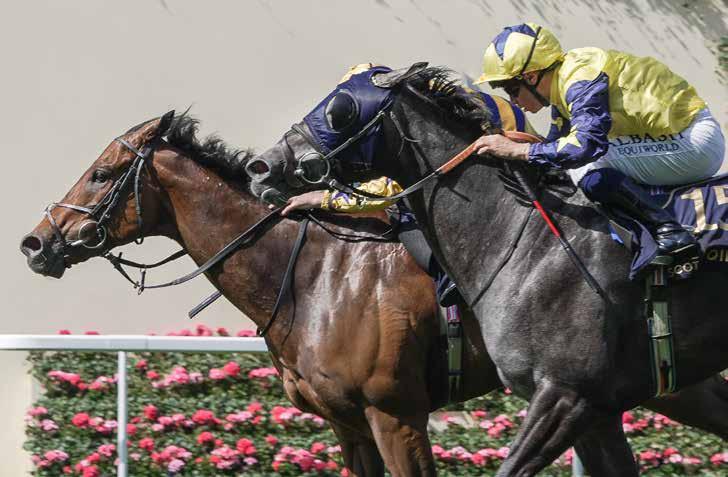
Another Fairyhouse graduate to make the headlines was Cercene, who sprang a 33-1 surprise in the Coronation Stakes (G1) to give her trainer Joe Murphy a first winner at the highest level after 48 years with a trainer’s license.
The daughter of Australia – who also featured as broodmare sire of the Group 1 winner Lazzat later in the week – had been a good third in the Irish 1,000 Guineas (G1), but was visiting the winners’ enclosure tor the first time since her maiden win last September.
Bred by China Horse Club International, she was purchased for €50,000 as a yearling at Fairyhouse.
A half-sister to the Brittania Stakes winner Perotto (New Bay), she is out of the maiden winner Tschierschen

American Affair (Washington DC): the five-year-old, trained by Jim Goldie and who goes by the nickname of Charlie, just gets up to deny the US-bred, William Knight-trained Frost At Dawn (Frosted) in the King Charles II Stakes
(Acclamation), a half-sister to the high-class juvenile Gallagher (Bahamian Bounty) and the Listed-placed Roodeye (Inchinor), dam of the top miler and young sire Mohaather (Showcasing).
The King Charles III Stakes (G1) served up another slice of storytelling as American Affair stayed on to win by a neck for Scottish trainer Jim Goldie.
The five-year-old gelding arrived at the meeting off the back of handicap wins at Musselburgh and York this season, and a recent fifth-place in the Temple Stakes (G2).
His victory gave his trainer and his sire, Bearstone Stud’s Washington DC, who also stands for the bargain fee of
£3,500, their first top-level success.
Bred by John McGrandles, the gelding is out of Classy Anne, a daughter of Goldie’s smart sprinter Orientor. The mare has already produced Classy Al, a prolific sprint winner at Ayr, having won six times herself in minor company exclusively at the Scottish tracks.
As McGrandles said in the post-race interview, American Affair was likely the only horse at Royal Ascot with a Glaswegian postcode.
The owner-breeder did not hang around at the London-based racecourse enjoying the celebrations – he and his wife had to get back home as they were due to show sheep the very next day at

Below, Starman’s daughter Venetian Sun winning the Albany Stakes (G3) from Awaken
the Royal Highland Show.
Special mention should also go to the stallions Twilight Son, Awtaad, Postponed and Phoenix Of Spain, who all got winners on the board and stand at fees of £/€10,000 or less.
Gstaad: another top one for Mosa Mine
The Coolmore/Ballydoyle conglomerate got off the mark for the meeting in the Coventry Stakes (G2) when Gstaad powered clear for a decisive victory.
Already a winner at Navan on debut, the colt was bred by Kelly Thomas’s Maywood Stud in Camarthenshire – an operation that has punched far above its weight in recent years thanks to this colt’s half-brother, the Group 1 winner and young sire Vandeek.
Gstaad, a son of Starspangledbanner, was purchased by MV Magnier for 450,000gns at the Tattersalls December Foal Sale in 2023, and looks likely to write several more success stories for connections.
He is out of the Exceed And Excel mare Mosa Mine, now the dam of five winners.
Winless in seven starts, Mosa Mine was bred by Thomas and sold for £9,000 at Doncaster in October 2008, before being bought back for just £800 three years later – truly the stuff of fairy stories.
The Coolmore partners were back in the winners’ enclosure a day later with True Love, who landed the Queen Mary Stakes (G2).
Runner-up on debut in Listed company at The Curragh, True Love filled the same spot behind Gstaad at Navan, but won well at Ascot.
One of four winners at the Royal meeting for No Nay Never, the filly was bred by Coolmore out of the Listed winner Alluringly (Fastnet Rock), making her a full-sister to last year’s Airlie Stud Stakes (G2) winner Truly Enchanting, and a half-sister to another Group 2 winner in Lily Pond (Galileo), from the ever-flourishing further family

of the mighty Urban Sea.
No Nay Never and the Coolmore team paired up in the Norfolk Stakes (G2) with the two-year-old Charles Darwin, who took command and stayed on to win for the third time in four starts.
A full-brother to the top-class juvenile and sire Blackbeard and the Listedplaced Run Away, they are out of the minor winner Muirin (Born To Sea).
On Day 4, the Tally-Ho Stud stallion Starman continued the sparkling start to his stud career when his daughter Venetian Sun landed the Albany Stakes (G3).
Bred by Tally-Ho and sold for 240,000gns at Tattersalls October Book 1, the filly is a half-sister to the Listed winner Sir Yoshi (Mehmas) and is out of the Listed-placed multiple winner Johara (Iffraaj).
The Listed Windsor Castle Stakes returned a poignant moment for the stallion ranks when Havana Hurricane landed the odds for his late sire Havana Gold.
Bred by Lady Cobham and born in 2023, just a month after the premature death of his sire, the colt was snapped up by his trainer Eve Johnson Houghton with Highflyer Bloodstock for just 9,000gns at the Tattersalls Somerville Stakes last year.
He is the first foal out of Spitfire Limited (Excelebration), whose best result came when runner-up in a Class 6 sprint at Wolverhampton at three, but is a half-sister to Lossiemouth – no, not her; Spitfire Limited’s half-sister is a Grade 2 winner over hurdles by Makfi – from the family of the Group 2 winner Diffident (Nureyev).
Lazzat: the son of Territories putting in a shift under James Doyle to win the Queen Elizabeth II Stakes
It was the second year that JohnsonHoughton had won the race with a son of Havana Gold having been successful in 2021 with Chipotle – he had cost a touch more as yearling, setting his trainer back 10,000gns at the Tattersalls Ascot Sale, the forerunner to the Somerville Sale.
The final juvenile race of the meeting went the way of Humidity, a winner in May on debut for breeder Cheveley Park Stud, but now sporting the colours of Wathnan Racing and successful the Chesham Stakes (L).
A rare juvenile winner for Ulysees, the colt is a full-brother to Holloway Boy, who won the same race in 2022, before going on to Group 3 success at four.
This Ascot the best yet for Wathnan Of course the meeting was not all about cheaply-bred winners and unheralded stallions; the upper echelons were as well represented as expected.
Special mention must go to Wathnan Racing, with the powerhouse represented
by five winners, matching the tally of the Coolmore/Ballydoyle axis, which finished the meeting as leading owner.
The winners began with last year’s Jersey Stakes (G3) winner, the admirable Haatem (Phoenix Of Spain), who followed up this year in the Listed Wolferton Stakes on the opening day, followed half an hour later by French Master (Frankel) in the Copper Horse Handicap.
On Wednesday, the 2023 Queen Mary winner Crimson Advocate (Nyquist)

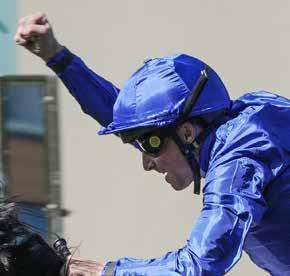

completed her reinvention as a miler when triumphing in the Duke Of Cambridge Stakes (G2), having appeared at the Royal meeting as a sprinter last year, when 15th in the King Charles III Stakes (G1).
After the success of Humidity on the final day, Lazzat (Territories) set the seal on a great week for his owners when triumphing in the Queen Elizabeth II Stakes (G1), in a battling finish with the Japanese raider Satono Reve (Lord Kanaloa).
Lazzat was already a Group 1 winner for his former owner and breeder Nurlan Bizakov and hails from the further family of the Classic winner Sleepytime (Royal Academy). His sire is now resident at Poonawalla Stud in India, having stood at Dalham Hall Stud for the last eight years.
Trawlerman: a Golden Horn star
Another former Dalham Hall Stud inmate also celebrated Group 1 success when Trawlerman put up a mighty performance to triumph in the Gold Cup (G1).
It was only back in March that we wrote in these pages about Golden Horn’s first top-level triumphs when he supplied a pair of Grade 1 winners at the Cheltenham Festival; less than four months later, the Overbury Stud resident can boast top level winners under both codes.
Bred by Godolphin, Trawlerman, who was runner-up by just a neck in the same race last year, was conceived in his sire’s second season at stud, when his fee was still £60,000. He is out of the Group 3-placed Tidespring (Monsun), who raced in the colours of Sheikh Mohammed.
Godolphin also celebrated Group 1 success with Ombudsman (Night Of Thunder) and Rebel’s Romance (Dubawi).
The former tasted defeat for the first time when runner-up in the Brigadier Gerard (G3) in May, but bounced back to winning ways in some style, triumphing by 2l in the Prince of Wales’s Stakes (G1).
Bred by James Hanly, the colt was recruited to the Godolphin team for 340,000gns at October Book 2.
He is out of the Dansili mare Syndicate, a full-sister to the Group winner Runnymede and the dual Listed winner Stipulate, out of the Juddmonte-bred winner Indication, a daughter of Sadler’s Wells.
Rebel’s Romance put the icing on Godolphin’s Royal Ascot cake when triumphing in the Hardwicke Stakes (G2).
The globe-trotting son of Dubawi, now seven, has clocked up more airmiles that a Ryanair pilot in his six seasons of racing, winning seven top-level races and amassing well over £10m in prize-money in six different currencies, and the bandwagon shows no sign of slowing.
The beautifully-bred Trinity College was another eye-catching winner by Dubawi when landing the Hampton Court Stakes (G3) on Day 2, after his recent fourth in the Prix du Jockey-Club (G1).
Bred by Coolmore, the colt is out of the dual Guineas heroine Hermosa (Galilleo), from the outstanding family of Beauty Is Truth (Pivotal).
The Night Of Thunder colt Ombudsman wins his fifth race from six starts succeeding on his first attempt at Group 1 level under a delighted William Buick
Earlier on Wednesday’s card, Garden Of Eden landed the Ribblesdale Stakes (G2), again for the Coolmore partners.
Purchased for €160,000 as a foal from Grange Hill Stud by Camas Park Stud and €200,000 as a yearling at Goffs when bought by Peter and Ross Doyle, the filly was out of luck in Group 3 company twice this season but got back to winning ways in Listed company at Naas in May, before posting success at Ascot.
By Saxon Warrior, the filly is a half-sister to Internationaldream (Acclamation) and is out of Komedy (Kodiac), who won in Spain and is a full-sister to Listed winner On Her Toes.
Last but by no means least, we should turn back to the opening day, which featured a mouth-watering class of the English, Irish and French 2,000 Guineas winners in the St James’s Palace Stakes (G1) and victory went the way of Field Of Gold in one of the week’s most impressive performances.
Runner-up at Newmarket, as was his sire Kingman, Field Of Gold hacked up at The Curragh three weeks later.
At Ascot he had over 3l in hand over the French Guineas winner Henri Matisse (Wootton Bassett), with his Newmarket conqueror Ruling Court (Justify) in third.
Field Of Gold, a son of Kingman,
was bred by Bobby and Honora Donworth at their Roundhill Stud, and purchased by the Juddmonte team as a foal for €530,000 at Goffs.
A half-brother to two winners, he is out of the Shamardal mare Princess De Lune, a full-sister to the Australian Group 2 winner and sire Puissance De Lune, the Group 2 winner Queen Power and the Listed winner His Majesty, and a three-parts brother to the Group 1 victor Zabeel Prince, who is by Lope De Vega.
They are, of course, out of the well-bred Princess Serena (Unbridled’s Song), who cost the Donworths $150,000 at Keeneland in November 2003.

Field Of Gold: the Kingman three-year-old is out of the young mare Princess De Lune, who had a filly by Ghaiyyath in 2024 and returned to Kingman this spring
Leading European Flat Sires 2025 (by prize-money earned to June 22, 2025)
Courtesy of Weatherbys








The World’s Leading Source of Royal Ascot Winners Success Delivered Not Just O ered
DOCKLANDS




QUEEN ANNE STAKES, Group 1
sold Tattersalls Ireland September Yearling Sale by Clenagh Castle Stud to Blandford Bloodstock for £16,000
sold Tattersalls December Foal Sale by Mickley Stud to Midland Equine for 18,000 gns
OMBUDSMAN
PRINCE OF WALES’S STAKES, Group 1
sold Tattersalls October Yearling Sale, Book 2 by Ballyhimikin Stud to Stroud Coleman Bloodstock for 340,000 gns

NOBLE CHAMPION
JERSEY STAKES, Group 3
sold Tattersalls October Yearling Sale, Book 1 by Chasemore Farm to SackvilleDonald for 500,000 gns
sold Tattersalls December Foal Sale by Ballylinch Stud to Chasemore Farm for 140,000 gns
HAATEM
WOLFERTON STAKES, Listed
TIME FOR SANDALS
COMMONWEALTH CUP, Group 1
sold Tattersalls Ireland September Yearling Sale by Rathbride Farm to Harry Eustace Racing / DPA for €35,000
CERCENE
CORONATION STAKES, Group 1
sold Tattersalls Ireland September Yearling Sale by Baroda Stud to Crampscastle Bloodstock for €50,000
GSTAAD

COVENTRY STAKES, Group 2
sold Tattersalls December Foal Sale by Maywood Stud to M V Magnier for 450,000 gns
VENETIAN SUN
ALBANY STAKES, Group 3
sold Tattersalls October Yearling Sale, Book 1 by Tally-Ho Stud to Todd Investments for 240,000 gns

sold Tattersalls October Yearling Sale, Book 2 by Sherbourne Lodge to Peter & Ross Doyle Bloodstock for 27,000 gns
HAVANA HURRICANE
WINDSOR CASTLE STAKES, Listed
sold Tattersalls Somerville Yearling Sale by Norris Bloodstock to Highflyer / Eve Johnson Houghton for 9,000 gns
ASCENDING
ASCOT STAKES
sold Tattersalls Autumn Horses In Training Sale by Beechdown Farm Stables to Kevin Ross Bloodstock / Henry De Bromhead for 100,000 gns
sold Tattersalls October Yearling Sale, Book 2 by Rathbarry Stud to Clive Cox Racing for 75,000 gns
MISS INFORMATION
KENSINGTON PALACE STAKES










NEVER SO BRAVE
BUCKINGHAM PALACE STAKES




sold Tattersalls October Yearling Sale, Book 1 by New England Stud to Blandford Bloodstock for 240,000 gns
ETHICAL DIAMOND
DUKE OF EDINBURGH STAKES
sold Tattersalls July Sale by Baroda Stud to Harold Kirk / WP Mullins for 320,000 gns
GET IT
WOKINGHAM STAKES
sold Tattersalls Autumn Horses in Training Sale by Beechdown Farm Stables to George Baker Racing for 40,000 gns


sold Tattersalls October Yearling Sale, Book 2 by Ballylinch Stud to Norman Court Stud for 90,000 gns
































Lambourn dominates
There was lots of debate after the colts’ Classic regarding Derby day and the quality of the race, but Jocelyn de Moubray believes the Classic was up to standard

EVERY YEAR at the beginning of June we are reminded that Epsom racecourse presents a challenge which is different from that posed by any other course.
Then we get a second surprise, as by the end of the day after watching the race unfold, we realise that the Derby is a similar spectacle year after year. It is not only that more often than not
it is won by a horse trained by Aidan O’Brien, the Ballydoyle trainer has won nine of the last 14 runnings and has secured a record 11 victories. To win the Derby a horse needs to be able to stay 1m4f, deal with the climb uphill from the stalls and then race downhill into the straight. All are such tests for young three-year-olds that the winner has has often already beaten his rivals at the top of the straight.
The Coolmore partnership’s Lambourn was not only a decisive Derby winner passing the post three and three-quarter lengths in front of Lazy Griff, but the son of Australia had the race definitely won by the time he reached the top of the straight.
The ground was good, or perhaps good to soft, but not in any way extreme. Three of this century’s winners –Harzand, Ruler Of The World and High
Lambourn was not for catching in the Epsom home straight, but the race-winning move was made by jockey Wayne Lordan after jumping out of the stalls

















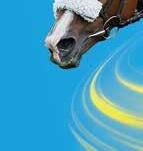


















































Chaparral – have a slower winning time than Lambourn’s 2m38.5s and, by way of a comparison, the last time the Derby was run on very soft ground, Teenoso won in 1983 in 2m49.07s, more than 50l slower.
According to timing expert Simon Rowlands, Lambourn reached the top of the straight in 1m57.25s, putting him 45th among the last 55 Derby winners at that point, some 40l in front of Teenoso and in front of Ruler Of The World, Harzand and High Chaparral.
Lambourn ran from there to the finish in 41.25s, the 40th fastest of the last 55 and the equivalent of some 15l slower than the top three – Galileo, Nijinksy and Auguste Rodin.
If there was a decisive moment in this year’s race it came when the stalls opened and Wayne Lordan on the winner and Christophe Soumillon on Lazy Griff pushed their mounts forward to take up a prominent position. Lambourn, closely followed by Lazy Griff, ran up the steep climb through the first two furlongs in 29.39s, in the conditions a very fast time, and some 6l faster than Whirl had done in the Oaks (G1) the previous day and 8l faster than Continuous in the Coronation Cup (G1).
AT THIS POINT a fair number of their rivals were already beaten, either pulling too hard or being left behind, struggling to find their balance.
From then on Lambourn and Lordan were given an uncontested lead as Soumillon eased Lazy Giff back into third place; the pair coasted down the hill into the straight and, once they quickened again, they were soon in a clear unassailable lead.
Lambourn ran the final three furlongs in 36.77s. The two who made the most ground at this point were the thirdplaced Tennessee Stud (35.77s) and the fourth New Ground (35.72), but they were too far behind at the top of the

straight to ever threaten the leader. In a slowly run race the time to make ground is before the leader accelerates.
On the day, Lambourn was clearly superior and displayed the combination of speed and stamina which makes a top class middle-distance horse. The best middledistance horses are in many ways the pinnacle of the thoroughbred because they have so many positive attributes – they can settle, and stay, and accelerate and run fast furlong splits and maintain their speed over a race of 1m4f.
None of the first four had raced a year ago – the first to do so was Lazy Griff who was second on his debut over 7f in mid-June. The quartet were good winners as two-year-olds the first three winning a Listed, a Group 3 and
a Group 1 in France respectively, while New Ground was unbeaten in two starts at two.
The decline of the Derby has been a topic of conversation or reflection in the racing press for at least 30 years.
And yes, it is sad to see the Downs so empty, and it is such a wonderful spectacle that everything necessary should be done to encourage people to come and see the race for themselves.
However, there were positive aspects of this year’s edition. It attracted a large field, with runners from Ireland and France, and on the morning of the race many different names were put forward as possible winners. It was won in an excellent style by Lambourn, who has plenty of scope to improve, who has
From the seventh crop of three-year-olds by Australia, Lambourn has scope for further improvement
done little wrong in his six starts to date and has succeeded in winning on three of the most difficult of racecourses in Craon, Chester and Epsom.
Who knows what he will be able to do on a flat galloping track?
It is unlikely he will become a great champion as this year the three-year-old crop appears to be a closely matched group at the top.
Lambourn is the sixth Group 1 winner from the first seven crops of three-yearolds produced by his sire, the Derby winner Australia.
Overall, from his first seven crops Australia has produced 714 foals of which 73 (10 per cent) are stakes performers, six (0.8 per cent) Group 1 winners and 17 (2.4 per cent) Group 1 performers.
It is a record that puts him among the best middle-distance sires in Europe, if not, of course, in the same league as his father and former stud companion Galileo. However, as 75 per cent of his three-year-old winners come over 1m2f or further, it restricts the opportunities they have and the demand for them in the yearling market.
Australia is also proving to be a promising broodmare sire as his oldest
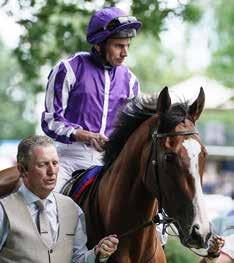
daughters are only nine and this year they have produced four black-type winners, headed by the Royal Ascot Group 1 winner Lazzat.
Lazy Griff’s second place is a wonderful achievement for all of those involved. The son of Protectionist was bred in Germany by Gestüt Westerberg, sold as a yearling at the BBAG September Sale for €75,000 to Jeremy Brummitt and races in the colours of the Middleham
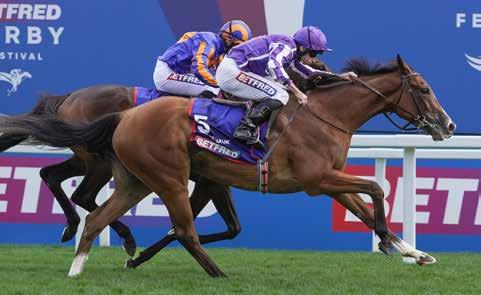
Park Racing syndicate. His success shows German-bred three-year-olds can compete on the international stage, and that syndicates can compete in the best middle-distance races.
Minnie puts in a big Oaks-winning performance
The Oaks was this year a lesser spectacle only because there were nine runners and, once it was obvious that the unbeaten 1,000 Guineas winner Desert Flower was not at ease on the track or at the distance, only two of the nine had a chance of winning – Coolmore’s fillies Minnie Hauk and Whirl.
Whirl and Lordan went off in front and, after a fast first furlong, were given an uncontested lead, however, the Wootton Bassett filly’s main rival and stable companion Minnie Hauk and Ryan Moore were always close behind, never more than two and a half lengths.
Whirl ran the final three furlongs in 36.25s, while Minnie Hauk put in 35.91s, which proved just enough for her to catch and pass her rival to win by a neck.
Minnie Hauk confirmed her sire Frankel’s position as the leading active European Classic sire.
She is the second Frankel filly out of a Dansili mare to win the Oaks after Soul Sister in 2023 and the third of his daughters to do after Anapurna won in 2019.
Whirl’s sire Wootton Bassett has yet to match these achievements but considering he started his stud career covering a handful of ordinary mares at a fee of €6,000, Coolmore’s sire is already remarkably successful.
He is the sire of three Classic winners, and this year his first Coolmore-sired three-year-olds have won two in France, Henri Matisse was victorious in the Poule d’Essai des Poulains and Camille Pissaro the Prix du Jockey-Club, while Whirl and Tennessee Stud finished second and third at Epsom.
There is every chance these two fillies will dominate the middle-distance races for fillies and mares for the year.
Above, the Oaks winner Minnie Hauk – below, nearside, she goes head to head with Whirl in the Classic
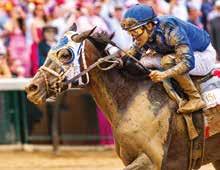

4 Classics in 48 hours...
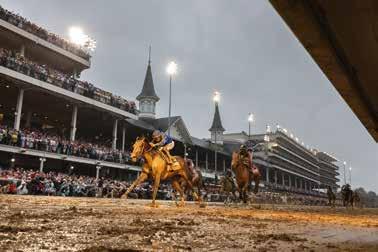


and years
The 2,000 Guineas and the Kentucky Derby. The Kentucky Oaks and the 1,000 Guineas. Tests that make stallions – and prove stallions. That make history. Three homebreds, one sales purchase. Two future Darley stallions, two by Darley stallions. The American double: last achieved in 1952. The Guineas: only three owners have won both since the war. But all four? Never before garnered by a single team as they were in 2025 – on one unforgettable long weekend. And almost five decades after Sheikh Mohammed’s awe-inspiring, all-inspiring first-ever winner.
Hatta, in 1977
Sheikh Mohammed’s first winner
Medaglia d’Oro’s

Art form
It was a French Classic year again for Aidan O’Brien, who won the Prix du Jockey-Club and the Poule d’Essai des Poulains with two different sons of Wootton Bassett
Henri Matisse (1) winning the 7f Group 2 Ballylinch Stud “Red Rocks” Stakes at Leopardstown before he went on to claim French Classic success over a mile at ParisLongchamp
THIS YEAR THE best races for the Classic generation in France have been competitive and entertaining with close finishes and even a disqualification, but no clear leaders have emerged among either the French-trained contenders or those who have come from abroad.
The Prix du Jockey-Club has become a different race in recent years as now it is run at a furious pace from start to finish. There have been 21 Jockey-
Clubs over 1m2f since Shamardal won the first shortened race in 2005. Of these, only four have been run in less than 2m5.0s, and all four of these fast winners, Camille Pissarro, Ace Impact, Sottsass, and Mishriff came in the last seven years.
Camille Pissarro’s winning time of 2m4.4s was more than four and a half seconds or some 22l faster than Shamardal’s 2m9s. Probably Shamardal was the superior racehorse of the two, but the test he faced that day in Chantilly was quite different to the one

Camille Pissarro overcame this year.
The John Gosden-trained Bowmark made the early running this year and covered the first 1100m in 1m4.05s. This is the distance from the start to when they race past the stables and begin the descent toward the chateau and the home turn. At this point Bowmark was closely followed by Trinty College, one of Aidan O’Brien’s runners, with a gap back to Cualificar in third and then a few lengths further behind O’Brien’s Camille Pissarro and Detain. The pace was a strong one but, aside from the leader, who dropped away from the first four home, were all prominent with 1000m to run.
Big Rock reached the same point in 1m3.43s in Ace Impact’s year and the fastest pace of all came in Sottsass’ year when Motamarris ran the first 1100m in 1m2.2s.
Once in the straight Camille Pissarro had to find a way around the tiring leader, but Ryan Moore was able to switch inside his stable companion Trinty College onto the rail and the son of Wootton Bassett quickened to take a narrow yet decisive lead to win by a halflength from Godolphin’s Cualificar with Detain, another son of Wootton Bassett, in third, Trinty College fourth and the Aga Khan Stud’s Azimpour and Ridari fifth and sixth.
The first six finished within 2l of each other and, if Camille Pissarro was clearly the best on the day, it would not take a dramatic change of circumstances for these colts to finish in a different order if they meet again.
The Poule d’Essai des Poulains (G1) was run in a similar fashion and the result was of the same order, too, as Henri Matisse, also a son of Wootton Bassett trained by O’Brien, was a narrow winner with the first six home all within two and a half lengths of each other.
Henri Matisse held the late challenge of the Andrew Balding-trained Jonquil to win by a head with Camille Pissarro, Luther and Ridari behind.
The pace set by Misunderstood, who covered the first 600m in 36.48s, was
Sosie finished fourth behind
Bluestocking
in
the Arc last year, a race which looks better than ever now
fast enough to set up a new race record, Henri Matisse winning in 1m33.91s.
O’Brien doesn’t yet dominate the French Classic races to the same degree as he does in England and Ireland, but for the second time in five years his Ballydoyle stable won both the Poule d’Essai des Poulains and the Jockey-Club.
This year it was two different sons from the first Coolmore-sired crop of Wootton Bassett, and the sire’s first Irish
crop has already produced four juvenile Group 1 winners, two Classic winners, Henri Matisse and Camille Pissarro, and three other Classic-placed horses in Detain, Whirl and Tennessee Stud.
The ground was clearly riding fast on the day of the Poules d’Essai des Pouliches (G12) as She’s Perfect and Zarigana recorded a time of 1m34.05, only fractionally slower than Henri Matisse’s race record
This year’s best German-bred three-year-old finished second in the Epsom Derby
IN GERMANY too there are no obvious stars among the three-year-olds, except for the German-bred Lazy Griff, who finished a fine second in the Epsom Derby.
Two of the best fillies’ races, the 1,000 Guineas in Dusseldorf and the Diana Trial in Berlin, were won by British-bred, Polish horses owned by Westminster Stud and trained by Andreas Wohler.
The Westminster Stud horses have the advantage of being ridden by the owner’s retained jockey Adrie de Vries, who has been on fire since returning from his winter in Dubai. The Territories filly Lady Ilze came from last, the only runner to ignore the crazy fast early pace, to win in Dusseldorf, and the Golden Horn filly Lady Charlotte maintained her unbeaten record when outstaying her rivals in Berlin.
The best three-year-old filly is almost certainly Volker Kaufling’s homebred Soldier Hollow filly Matilda, who put in an astonishing performance to win the German 2,000 Guineas by six and a half lengths leaving in her wake French and English-trained colts and fillies.
This was only the third career start for the Yasmin Almenrader-trained filly, who looks to have a big future.
She is out of the Giant’s Causeway mare Modesty’s Way, who was bought from the Niarchos family for only €7,000 in 2019. Her third dam is the Niarchos champion Chimes Of Freedom.
In the fillies’ race She’s Perfect, the early leader, went through the first 600m in 37.97s and so about 7l slower. The Charlie Fellowes-trained Sioux Nation filly made the most of her uncontested lead and was among the first to accelerate at the top of straight.
At this point Mikael Barzalona and Zarigana were around 4l behind the leader. As has been well documented, Zarigana showed a great turn of foot to draw alongside the leader, but the daughter of Siyouni could not get past and on the line was still a nose behind.
The Aga Khan Stud’s filly was subsequently awarded the race by the stewards, becoming her sire’s eighth
Almenrader, who has only 31 horses listed in her stable, came close to another incredible result when Hochkonig, a son of Polish Vulcano, a son of Lomitas who stands cheaply in Germany, was beaten only a length in the Group 2 Union Rennen by the new Derby favourite Zuckerhut with the rest of the field three lengths or more behind.
Zuckerhut, owned and bred by Gestüt Hachtsee and trained by Peter Schiergen, is a son of Almanzor, the third Group 2 winner this year from his fourth crop of three-year-olds after Gezora in France and the Italian Derby winner Molveno.
Unraced at two, Zuckerhut won well on his debut and then finished fourth in a Group 3 in Munich before improving significantly to win the Union Rennen on his third start.
His dam, the Samum mare Zamrud, was a Group 2 winner and second in the Preis der Diana, while his third dam Mercalle won the Group 1 Prix du Cadran in France and produced the Japanese champion three-year-old filly Fabulous La Fouine.
Zuckerhut is a sure stayer, and the lightly-raced colt could easily improve further between now and Hamburg in July.
His main rival in the ante-post market, aside from any possible foreign-trained challengers, is the Wohler-trained Best Solution colt Delgardo.
Delgardo beat Hochkonig to win his maiden over 2400m in April, with the rest of the field 12l behind, and then returned to win a Listed in Dusseldorf at the end of May.
From the second crop of Best Solution out of the Mount Nelson mare Delegation, who was an ordinary racemare, but whose first three foals are all winners and two now stakes winners.
The German-bred Lazy Griff (right, light blue and orange) ran a cracking race to take second in the Epsom Derby
“major” European Classic winner.
This was another bunch finish as Mandanaba, Exactly and Better Together were all within a length and a half of the first two at the line.
Impressive bunch of older horses
If the best French-trained three-yearolds are a closely matched group, three four-year-olds have already put up performances of the highest class.
The Wertheimers’ Sea The Stars colt Sosie won both the Group 1 Prix Ganay and Prix Ispahan over 2100m and 1850m, showing once again that the best middle-distance colts have the speed to
win over distances short of their best.
The Andre Fabre-trained colt will no doubt be prepared for another tilt at the Prix de l’Arc de Triomphe.
Sosie finished fourth behind Bluestocking last year in a race which looks better than ever now.
The third then, Los Angeles, has also won a Group 1 in 2025 and the second, the Wertheimers’ Sea The Stars filly Aventure, has looked better than ever with two brilliant wins, the latest coming in the Prix Corrida (G2) over 1m2f.
Aventure comes from a family developed by Guy de Rothschild from whom the Wertheimers purchased Aventure’s third dam Featherhill.
The third top-class older horse in France is the Aga Khan Stud’s four-yearold Frankel gelding Candelari, who won the first Group 1 Prix Vicomtesse Vigier over 3100m from a strong international field.
The Francis Graffard-trained gelding made his career debut last December and became a Group 1 winner on his fifth start having been beaten on his Group race debut just a month earlier.
Candelari’s second dam Caribbeandriftwood was part of the Aga Khan’s purchase from Jean-Luc Lagardère, and dam Candara had already produced several top staying horses, including Candarliya and Canessar.

horses to follow
Horses to follow
The Trackside team has been out and about at the races this spring and has listed plenty of exciting types in the notebook and on its text service
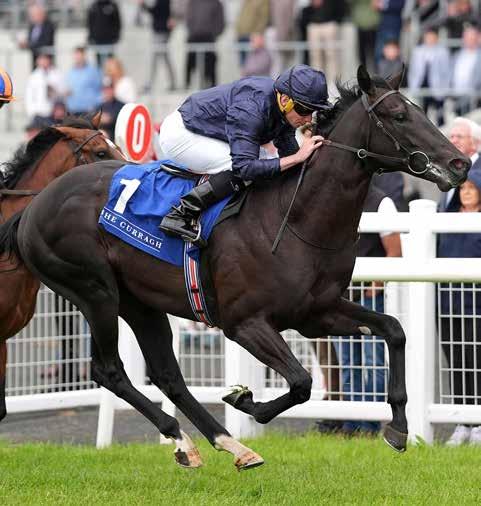
Brussels
2yo, c. Wootton Bassett-Fond Words (Shamardal)
Trainer: Aidan O’Brien
Breeder: Haras Des Trois Chapelles
Owner: Mrs John Magnier/Michael Tabor/Derrick Smith/Westerberg
Wootton Bassett’s stratospheric rise to the fringes of super-sire status has continued in 2025 with his first and second Irish crop already proving the purchase of the stallion by Coolmore worthwhile (see International Thoroughbred’s Xtra newsletter Week 3, online).
With Henri Matisse and Camille Pissarro winning French Classics for their sire, it has been interesting to see the new crop of juveniles come through and two exciting sons of Wootton Bassett were unveiled over Irish Guineas weekend.
The hype around Albert Einstein’s victory in the Group 3 Marble Hill Stakes probably overshadowed the impressive maiden success of his stablemate Brussels in the 6f maiden, where he cruised to an easy three-quarter length win over Kansas.
There was plenty of media coverage regarding the size of Albert Einstein
Left: Brussels winning his Curragh 6f maiden on his race debut at the end of May
Geography caught the eye on his first visit to the UK when sixth in the Group 3 Diomed Stakes behind Persica, impressing in the paddock with a lean, athletic appearance
(540kg, according to an effusive O’Brien), but Brussels would not be far away from that either – he is an impressive, burly colt in the Classic stamp of his sire.
Although he looked sharp enough over 6f, half-siblings have won over seven and you’d expect to see this colt come to the fore later in the season.
Troia
3yo, f. Kingman-Umniyah (Shamardal)
Trainer: Ed Walker
Breeder: Fittocks Stud & Andrew Bengough
Owner: Fittocks Stud & Andrew Bengough Troia earnt a place in the Trackside’s Horses To Follow section in December’s International Thoroughbred and she retains her place after an excellent start to the season.
Given an inauspicious return in a Catterick novice, the daughter of Kingman out-ran expectations when third behind Kon Tiki in the Listed Michael Seely Memorial Fillies’ Stakes.
Trainer Ed Walker was keen to emphasise the filly would not want a fast surface in pre-race comments and a warm week at York where the ground was quickening probably did not play to her strengths.
This proved to be true when she took the Listed Prix Volterra on soft at ParisLongchamp in early June, leaving a variety of possibilities for a late summer/ early autumn campaign.
From the family of Storming Home, Troia’s dam Umniyah has produced offspring capable of performing from 6f right through to middle-distances and now Troia has a valuable black-type victory on her record, the options appear open.
Sea Of Kings
3yo, c. Sea The Stars-Holy Moon (Hernando)
Trainer: Harry Eustace
Breeder: Razza Del Velino Srl
Owner: Wathnan Racing
Sometimes a horse really jumps out in the paddock and is immediately put in the notebook for the remainder of the season – this was the case with Sea Of Kings at Nottingham in April.
A muscular, deep-chested colt, reminiscent of his sire, he produced a fair performance to finish second behind the well-fancied Shadwell gelding Munsif, despite showing signs of inexperience in the closing stages.
Privately sold to Wathnan Racing in early May, he was disappointing on his first start in new colours when third in a novice at Chepstow.
It seems likely that Sea Of Kings may take a little time to come to hand and breeding would suggest he will be worth the wait.
Out of Hernando mare Holy Moon, the colt is a half-brother to eight individual black-type winners, including the illfated dual Group 1 heroine Sea Of Class.
Elwateen
3yo, f. Dubawi-Tawkeel (Teofilo)
Trainer: Saeed bin Suroor
Breeder: Shadwell Estate Company Ltd
Owner: Shadwell Estate Company Ltd
Although it could be argued that a Shadwell filly with the breeding of Elwateen should be physically impressive, it would be wrong to not draw attention to this beautiful daughter of Group 1 Prix Saint-Alary winner Tawkeel.
An eye-catcher before the 1,000 Guineas at Newmarket, she out-performed

expectations finishing a strong fourth, only two-and-a-quarter lengths behind Godolphin’s Desert Flower.
Given her larger frame and athletic walk, the Oaks seemed an ideal next step for the Dubawi filly and she was subsequently supplemented for the second fillies’ Classic of the season.
At Epsom, she was raw and green; pawing and looking around in preliminaries, reminding watchers of her lack of experience after only two previous starts.
A return to quieter surroundings, allowing Elwateen to learn her craft would seem an ideal next move –connections will also be keen to pick up some valuable black-type for her eventual next career in the breeding shed.
Geography
4yo, g. Holy Roman Emperor-Guajara (Montjeu)
Trainer: Peter Schiergen
Breeder: Stiftung Gestut Fahrhof
Owner: Stall Hanse
A German-trained gelding may not seem
Harry Eustace: trainer of the good-looking and imposing three-year-old colt Sea Of Kings
horses to follow
the obvious candidate for a Horses To Follow feature, but Geography caught the eye on his first visit to the UK when sixth in the Group 3 Diomed Stakes behind Persica, impressing in the paddock with a lean, athletic appearance.
Recently gelded, this son of Holy Roman Emperor is a three-time Group 3 winner in his native Germany, showing his best form on good to soft ground over a mile.
He boasts a smart pedigree to boot with his Listed-winning dam Guajara (Montjeu), one of three black-type performers for Global World (Big Shuffle), all of whom were trained by Peter Schiergen.
Ground appears key to Geography,
who has thrown in the occasional poor the good performance, and a mile Group race in France over the summer might provide him with an opportunity to extend his winning tally – the Group 3 Prix Daphne or the Group 3 Prix Quincey at Deauville come to mind.
My Cloud
4yo, c. Blue Point-Beach Frolic (Nayef)
Trainer: Roger Varian
Breeder: Coolmore
Owner: KHK Racing Ltd
My Cloud was selected by us before his smart victory in the Royal Hunt Cup at Royal Ascot, and this four-year-old is a colt on an upward trajectory.

Quietly campaigned at two and three with only a trio of outings, Roger Varian’s charge returned with an impressive Ascot victory in April – the Trackside paddock note then reading “not fully fit, but appears far superior to these”.
It wasn’t an unreasonable suggestion: My Cloud hails from a beautiful pedigree and his physical appearance lives up to his illustrious relatives.
Out of Beach Frolic, the muscular fouryear-old is a half-brother to the fivetime Group 1-winning miler Palace Pier and is a similar type – deep-chested, burly and powerful.
Connections have been patient with their talented colt and it looks to have paid dividends, with Group race options on the horizon in the second part of the year.
Reyenzi
3yo, c. Saxon Warrior-Reynira (Lope De Vega)
Trainer: Johnny Murtagh
Breeder: H H The Aga Khan’s Studs Owner: Exors Of The Late H H Aga Khan An impressive 5l victor of a 20-runner Navan maiden, Reyenzi went into the Group 3 Gallinule Stakes as a lively contender against Aidan O’Brien’s duo of Shackleton and Thrice.
The son of Saxon Warrior is lightframed and athletic but showed his vast inexperience in the closing stages of the 1m2f contest, hanging right as he reached the front and hampering rivals.
Subsequently demoted from victory to third in a lengthy stewards’ enquiry, the Aga Khan Studs-owned colt remains the horse to watch out of the race and expectations appear to be high.
He holds entries in the 1m2f Group 3 International Stakes on Irish Derby weekend and the Group 1 Irish Champion Stakes later in the season –connections believe they have a quality 1m2f colt on their hands, rather than going the traditional Gallinule-Irish Derby route.
My Cloud wins the Royal Hunt Cup: jockey Silvestre De Sousa reported that the “horse is going places”

Sovereignty reigns
It was a US Triple Crown series for the century, writes Jill Williams, who saw the best two colts in the states dominate the three races
AFEW HOURS after Lambourn crossed the winning post at Epsom,
the American Triple Crown was wrapped up across the pond after one of the most entertaining and satisfying three-race series in recent memory.
It was a brilliant five weeks full of twists and turns, but, at the end, it all came down to clearly this year’s two best three-year-old colts in the US: the Grade 1 Kentucky Derby winner Sovereignty and the Grade 1 Preakness Stakes winner Journalism.
Somewhat reminiscent of 1989 and the fondly remembered East v West showdown between Easy Goer and Sunday Silence, this season’s two colts are based on opposite coasts, trained by two of the classiest horsemen in the game.
In 1989, no one would have dreamed the strapping Easy Goer would be beaten into second in two of the three Classics, but that’s exactly what history shows and exactly what happened this year, as well.
Journalism, like Easy Goer, widely endorsed as one of the most obviously talented and imposing sophomores of his decade, was favoured in all three legs of the Triple Crown.

However, just like when Sunday Silence proved his mettle all those years ago, it is Sovereignty who now holds the advantage.
When the two shook off the rest of the field and the battle was joined past the eighth pole in the Derby at Churchill Downs, Sovereignty was moving better of the two and went on to take the first Classic by over a length from Journalism, giving Godolphin a welldocumented first Derby win during an unprecedented weekend that saw the operation double up on Classics in both the US and Britain.
The American sport barely had time to bask in the hugely popular victory before it was announced – less than 72 hours later – that Sovereignty would skip the Preakness in order to point to the
Belmont, with Hall of Fame trainer Bill Mott electing to give his colt more time between races.
No one could begrudge Mott for doing what he felt was right for the horse, but it sparked an outcry about proposed changes to the Triple Crown.
The majority of US trainers at the highest levels are trending toward giving horses several weeks between starts, but of course the spacing between the Derby and Preakness
currently allows for only two weeks, with five weeks total for the trio of races.
It seemed everyone in the US had an opinion, with progressive sorts wanting to elongate the series – many calling for a month between each race –while traditionalists want to retain the status quo.
Like its UK counterpart, the US Triple Crown is supposed to be the sternest of tests, with only the most special of athletes able to sustain peak performance against elite competition during such a demanding schedule.
The US has seen 13 Triple Crown winners, but without Sovereignty even in the Preakness, there was never going to be a chance to add a 14th in 2025.
Journalism promptly put the timing argument to bed, at least for this year, delivering what has to be one of most compelling performances ever seen.
After courageously bullying his way late into a diminishing hole only to be smashed between rivals, causing the sport to hold its collective breath while praying horses would keep their feet under them, Journalism looked impossibly beaten. Somehow, miraculously, in an effort that has to be seen to be believed, he gallantly kept his balance and scrambled free to unfurl
Sovereignty (red cap) after track work at Saratoga before the Belmont

a scintillating turn of foot in the lane, erasing a 5l defecit in the final furlong to score an inconceivable victory.
The performance electrified racing in US, setting up a much-anticipated showdown between the Derby and Preakness winners in the Triple Crown’s final leg.
The excitement in the air was palpable at the Belmont, held for the second year at Saratoga Race Course and at just 1m2f due to massive renovations at Belmont Park.
With Journalism slightly favoured on the day, the two colts both got clean trips and held every chance. Two furlongs from home, Journalism found the front first, but Sovereignty ranged up to look him in the eye, then went by in an instant.
Just as with Easy Goer 36 years previously, there is no doubt Journalism is an exceptional horse, and he ran what would have been a winning race – nay, very likely a Triple Crown-winning campaign – nearly any other year. If Sovereignty has now beaten him fair and square in their two meetings, how extraordinary must Sovereignty be?
“I can’t say enough good things about that horse or about my horse,” said Journalism’s trainer, Michael McCarthy.
“He’s a fantastic horse,” McCarthy said of his own charge. “He’s done what very few horses can do, three races in five weeks, Triple Crown races, [and finished] second, first, second. Take nothing away from him. He’s very, very good.”
These days, true rivalries at the elite level in US racing are relatively rare and brief. What a dream it would be if these two special colts, each ultra-talented and ultra-competitive, were able to continue theirs beyond the Triple Crown season.
Mott has already announced Sovereignty’s main goals to be the Grade 1 Travers Stakes, held at Saratoga in late August, and the Grade 1 Breeders’ Cup Classic, which will be held in California at Del Mar – in Journalism’s backyard –at the very beginning of November.
McCarthy has said “a lot of races [could be] in play” for Journalism and indicated those could be his targets as well. Fingers crossed.
Broodmare of the Year keeps delivering Amazingly, there’s a third colt in this year’s stellar three-year-old crop who also deserves mention.
Baeza, trained by John Shirreffs of Zenyatta fame, has won just one race in his nascent career, yet he finished just behind Journalism in the Grade 1 Santa Anita Derby and filled out the trifecta in both the Kentucky Derby and Belmont.
The May colt was brought for $1.2 million as a Keeneland September yearling after his half-brother Mage won the 2023 Derby. Last year, his halfbrother Dornoch won the Belmont.
In a remarkable accomplishment, Baeza’s Derby third marked the thirdstraight year that the trio’s dam had a runner in the Derby.
Only nine mares have ever produced two American Classic winners – Baeza gave his dam the chance to be the first to produce three. Named Broodmare of the Year for 2024, Puca has a yearling full-brother and a foal full-sister to Mage and Dornoch.
In an unconventional move that no one saw coming, owner John Stewart announced earlier this year she’ll soon be travelling to the UK to be bred to Frankel on southern-hemisphere time, staying long enough to repeat that mating back on a northern-hemisphere schedule.
It’s an out-of-the-box idea by Stewart, who purchased her privately for $2.9 million in 2023.
Embarrassment of riches in the sire ranks Puca isn’t the only one breathing rarefied air these days – Spendthrift Farm’s Into Mischief became the first sire since Bull Lea in 1957 to notch a third Kentucky Derby winner when Sovereignty crossed the line first at Churchill Downs. Only five stallions have ever achieved
the feat with Into Mischief getting all three of his in the last six years. To sweeten the pot even more, last year’s Derby winner was sired by his first-crop son Goldencents, who stands alongside him at Spendthrift.
Into Mischief’s reign is showing no signs of abating – he started out the hard way and his best books of mares have coincided with his Derby results.
He has led the US sires’ list for the last
six years running and, in no surprise, is loose on the lead for 2025, as well. Also among the perennial leading sires in the US is Darley’s stalwart Medaglia D’Oro. He is in the twilight of his career at age 26, but he continues to cover mares and continues to come up with top horses. His sophomore daughter, Good Cheer – like Sovereignty a Godolphin homebred and part of that quadruple Classic weekend –gave Sheikh

Mohammed’s global operation a second Grade 1 Kentucky Oaks winner in the past three years. She marked Medaglia D’Oro’s third Oaks winner, making him just the second sire in history with three.
Looking ahead to the second half
With the 2025 Triple Crown in the books, it’s time to look forward, with the elite summer season at Saratoga
always highly anticipated.
Also injecting the sport with enthusiasm is the return of Belmont Park as a host site for the Breeders’ Cup, as announced by the organisation in late May.
With its sweeping turns and proximity to the UK – at least in comparison to Santa Anita on the other coast –Belmont has proved an extremely desirable location in past years for the
year-end championship.
In the regular rotation during the Breeders’ Cup’s early years, Belmont has hosted the event four times, but not since 2005.
Fans and horsemen alike have lamented its omission from the schedule, making the upcoming 2027 edition an early crowd pleaser.
The Breeders’ Cup will be held at Del Mar this fall and at Keeneland in 2026.

Sovereignty (Into Mischief), crosses the finish line 3l ahead of Journalism (Curlin) and Baeza (McKinzie) to win the 157th Belmont Stakes run this year at Saratoga and over 1m2f
Toronado is right at home at Swettenham Stud
We chat with Adam Sangster who stands the son of High Chaparral – he has been well rewarded, the 15yo stallion heading for his best Australian season by prize-money earnings


Use this QR code to listen to Sangster’s interview in the Weatherbys section on the Nick Luck podcast, February 2024


SLIDING DOORS MOMENTS. Split seconds that differentiate the course of history, personal or global.
Adam Sangster has experienced a couple of those in his role as principal of Swettenham Stud. Two decades ago Coolmore offered him the opportunity to stand High Chaparral at the Victoria farm when the organisation decided that its Derby and Breeders’ Cup Turf hero should shuttle to the southern-hemisphere.
Sangster completed his due diligence, questioning his Australian breeders in order to elicit the level of interest and
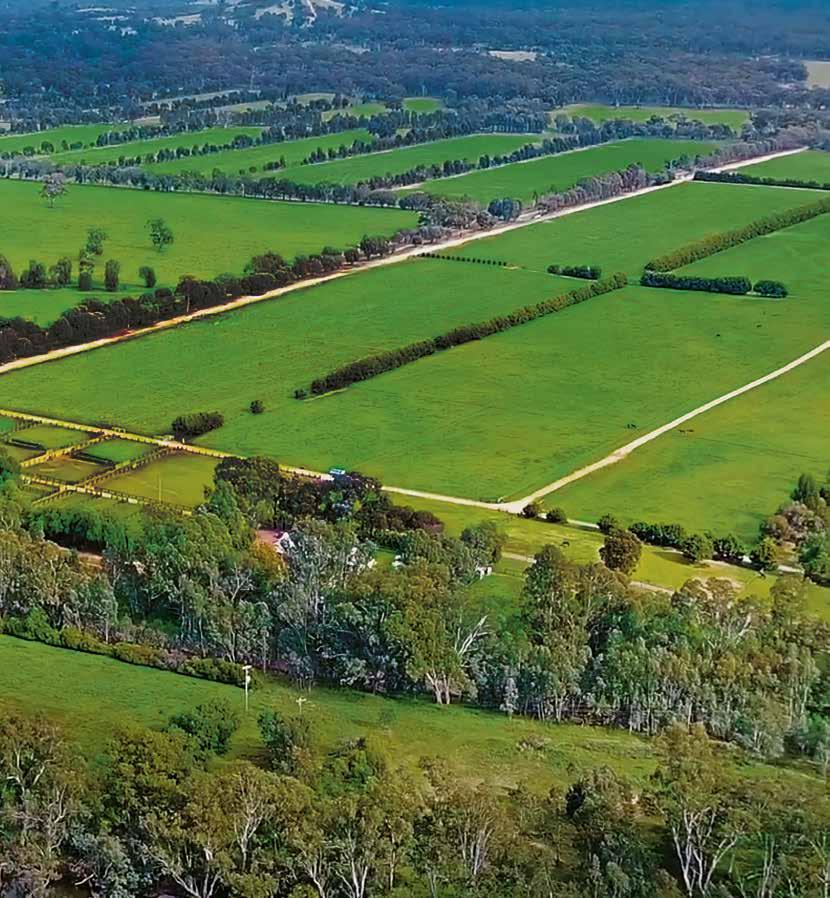
support that there would be among his clients for a middledistance star by Sadler’s Wells. His enquiries made the decision for him, and although he would have loved the opportunity to stand a brilliant son of the iconic horse bred by his father, the breeders spoke and declined.
So, instead, High Chaparral began his southern-hemisphere career in New Zealand at Windsor Park Stud where he sired the dual hemisphere champion and leading sire So You Think, as well as the Australian Derby and multiple Group 1 winners Dundeel and Shoot Out amongst others before transferring to stand in Australia at Coolmore’s base at Jerry Plains.
Above, Swettenham Stud’s Adam Sangster (right) with Al Shaqab’s Sheikh Joaan
When, a decade later, the opportunity to stand a top-class son of High Chaparral arose Sangster, who had watched High Chaparral’s career and that of So You Think with fondness, outlines: “When John Warren and Harry Herbert were working with Al Shaqab, they came down here and I was chasing Olympic Glory as well and, it just shows you that you need a bit of luck, they said that he was not possible, but we’ll give you Toronado. I was delighted –Toronado was a champion miler.
“Twenty years ago, we didn’t take High Chaparral – I took Hold That Tiger instead and it just shows you that sometimes opportunity knocks and you don’t answer! This subsequent chance to stand a son of High Chaparral in Toronado was a fortuitous event and a game changer for me.”
The logic in standing Hold That Tiger was sound – a European champion two-year-old and a son of Storm Cat he seemed the perfect fit for Australia. However, while High Chaparral flourished, Hold That Tiger faded into obscurity.
But, as Sangster goes on to further reflect, some things are meant to be.
“High Chaparral went to New Zealand instead and, if he hadn’t, we would never have got So You Think, who was a ten-time Group 1 winner and is an excellent sire in Australia.”
THIS TIME AROUND, Toronado has dazzled under the Southern Cross, so much so that he no longer returns to Al Shaqab’s Haras de Bouquetot for the northern-hemisphere season.
“I have good pedigree guys who said the pool of mares in Australia would suit Toronado well, being mainly Danehill mares and Green Desert mares, who seem to work very well with him,” says Sangster, adding: “They did, and I bred a Group 1 winner in his first crop.”

That top level performer was the Galaxy winner Mariamia, who was sold by Swettenham for just A$18,000 as a yearling at the 2017 Inglis Premier Sale, but went on to top last year’s Day 2 of the Magic Millions National Broodmare Sale when making A$1.8m.
Her 2023 Galaxy victory was the second successive win in the race for progeny of Toronado following that of Shelby Sixtysix in the five-and-a-half furlong race in 2022 – and the pair are two of the six top-level winners the Queen Anne and Sussex Stakes victor has sired in the US, Hong Kong and Australia.
As Al Shaqab does not have a large presence in the southern-hemisphere, Sangster knew he would have to put the heft of Swettenham behind Toronado if the stallion was to have a chance of emulating his sire and succeed in Australia.
“I knew I had to get behind this stallion so I went out and bought a significant number of mares to make
sure that his numbers would be high in that first year, because that is so important,” he says.
Toronado’s fee for this year’s upcoming covering season has been set at A$88,000 (inc GST), which is four times the price at which he was introduced to Australia breeders in 2015.
With the recent success of Helios Express and Victor The Winner in Hong Kong, Toronado’s star is burning bright. In the sale ring, he sired his first million dollar yearling this spring when Gilgai Farm, breeder of Group 1 winner Masked Crusader, sold a colt at Inglis Premier to Andrew Williams Bloodstock and Hong Kong Bloodstock for exactly that figure.
“He threw a great foal which subsequently turned into a great yearling,” says Sangster.
This year’s yearlings are the stallion’s most expensively bred to date at a fee of A$80,000, while this season’s current two-year-olds were bred at a fee of
Toronado: by High Chaparral, is standing at a fee of A$88,000 (inc GST) for 2025


Wooded: the son of Wootton Bassett’s
A$45,000, his previous highest price.
Sangster attributes Toronado’s success to a number of factors.
“Richard Hannon trained the horse and every time I see him he asks, ‘How’s superman getting on?’ Toronado has that muscle definition and when breeders see him they love him,” he smiles.
“In his first crop he got a really good sprinter called Prince Of Sussex, who won the million dollar two-year-old race [Vobis Showdown].
“That horse went to Hong Kong and was renamed Lucky Express and trainer John Size won races with him, so it meant that the Hong Kong market
really focused in on Toronado.
“Rick Jamieson [Gilgai Farm] who bred Black Caviar amongst others, really supports Toronado and he was duly rewarded in the Melbourne sale here where he sold that top yearling. He had four or five Toronados and they all went to Hong Kong.”
While other stud owners may be concerned that their star stallion’s prospects of siring an heir are limited because of the proliferation of geldings with so much success in Hong Kong, Sangster is not worried. Toronado is still only 15 and Australian owners are as much in the market for him as those overseas.
“The colts are so well sought after,” he says. “People do say to me it is a bit of a shame that they go to Hong Kong, but people have made good money on Toronados in Australia because they have traded the colts and geldings up there.
“He is only going to get better, he is a lovely horse,” Sangster remarks and with an eye on the future says, “He has the right sort of mares, the right mixture and he is at A$80,000 now.”
THE SUCCESS OF Toronado
cemented the relationship between Al Shaqab and Swettenham Stud, and when the decision was taken to shuttle the Prix de l’Abbaye (G1) victor Wooded, the Victoria farm was always going to be the destination for the Qatar operation’s Group 1-winning sprinter, who is by the biggest stallion star in the galaxy right now.
“Wootton Bassett was sold to Coolmore so Al Shaqab retired Wooded at the end of his three-year-old season to get a good start,” Sangster says of his shuttle stallion. “He has that lovely pedigree, his full-brother [Bucanero Fuerte] is a Group 1 winner and his half-sister by Dubawi was sold for €2,400,000, and he has been well-supported down here.”
festival data analysis
With two Classic winners from the first Coolmore-bred crop of Wootton Bassett, half of the astonishing four juvenile Group 1 winners from that debut Irish crop, the current support and momentum behind the Iffraaj stallion is strong in Europe and Australasia.
“Coolmore has really got behind Wootton Bassett and we have the only sprinting son of his standing at Swettenham, and it is thanks to Al Shaqab,” Sangster expresses his gratitude for the partnership with Sheikh Joaan’s breeding operation.
Wooded’s first French-bred crop are three-year-olds and the best is Woodshauna, who emulated his sire by winning the Group 3 Prix Texanita.
Sangster says of Wooded’s Swettenham yearlings: “His first crop here are turning two on August 1. His yearlings have sold really well, hopefully we are ahead of the curve a little bit. We have supported him strongly and some of my yearlings have sold very well to some good judges.”
Wooded’s average at the southernhemisphere yearling sales was A$66,035, three times his covering fee, which has been set at A$16,500 (inc GST) for the upcoming breeding season.
Swettenham Stud has been in its current location of Nagambie for 30 years with Adam Sangster its sole owner for 21 years.
His experiences, his enthusiasm and
his passion remain as animating as ever, but he is concerned for the future of the industry despite how buoyant and resilient it appears at the highest levels.
As in Europe and North America, the dictates of fashion seem to hold sway over so much beyond the breeders’ control.
“We feel the market here still offers good opportunities but the costs of breeding have gone up,” he outlines.
“It’s an expensive business, it costs around A$40,000 without the stallion fee just to get to the yearling stage so you need to get a return in the sales ring, and you need the sales companies to respect your stallions as well,

Toronado winning the Group 1 Queen Anne Stakes: the horse also won the Group 1 Sussex Stakes and was three times runner-up at the highest level

so that breeders can get their horses into the sales.”
To that end, Swettenham rolled out its Breeder Protection Initiative for this season as a way of offering something of an insurance policy for smaller breeders in particular.
“It’s something we do because the stallions we have are owned by people who understand the industry and how hard it is, especially if you lose a foal,” he explains.
“In the past we have offered free returns if someone loses a foal, but we have never put that down on paper.
“Some friends and clients suggested that we should push that out because other farms don’t do it.
“It’s protecting the breeder because they know if they have a compromised foal, if they paid the service fee, they can come back and try again. It has been a really good tool for us.”
He adds: “We understand how hard it is for breeders to make a dollar.”
The success of racing in Australia, that appears to permeate society more than in Europe, is often quoted and much is attributed to the syndication model of ownership; it has given the opportunity to those with a passion for the sport to become involved.
Sangster offers statistics that illustrate that cultural acceptance with one in 191 people in Australia owning a
share in a racehorse, and that is a model he would like to see expanded to the breeding industry.
“People looking to breed would like to get involved in these top-end mares and race fillies off the track, but they are too expensive at the moment.
“If you pool together in a syndicate or even micro shares it could be the way to get involved in a top-class race filly.
“It could be a great opportunity to understand how the breeding game goes without putting all your eggs in one basket.”
As is making the decision whether or not to stand a stallion.
Sliding Doors. moments that can lead in any direction.

It could be a great opportunity to understand how the breeding game goes without putting all your eggs in one basket ...
Wooded was retired to stand at Al Shaqab’s farm Haras de Bouquetot for the 2021 season after his victory in the Group 1 Prix de l’Abbaye

Vandeek heading off Down Under
We chat to Cheveley Park Stud and Australia’s Arrowfield Stud about the plans to shuttle the young sire for this year’s southern-hemisphere season

THE DUAL Group 1-winning two-year-old Vandeek has just come to the end of his first season at stud, but the grey stallion is not kicking up his hooves on holiday in Newmarket and enjoying the summer season in the UK, rather his bags are being packed for a six-month stint on duty as a shuttle sire in Australia.
The son of Havana Grey, who has stood his first season at Cheveley Park Stud, part-owed by the farm alongside his racing owner KHK Racing, who had such a successful time of it with the horse on the track, has attracted the attentions of a southern hemisphere patron – Arrowfield Stud in the Scone Valley, New South Wales.
The stallion is travelling to his summer (winter) home at the beginning of August for the Australian covering season and Arrowfield’s bloodstock manager Jon Freyer explains that the idea has been something of a long-term plan for the farm.
“He was on our radar during his two-year-old season and when Cheveley Park Stud moved quickly to secure an interest in him, we reached out to explore
the possibility of shuttling him,” recalls Freyer. “We’ve done good business with Cheveley Park Stud in the past with Danzero, so it was easy to reignite that relationship and it was a perfect opportunity all round.”
It was Vandeek’s outstanding ability on track that appealed to Arrowfield to consider him as a suitable prospect for Australian breeders.
“He’s a horse who has shown incredible natural ability right from his breeze-up to his first start, through to Group class then Group 1 success, and he had tremendous speed and precocity –qualities that make him very attractive for Australian breeders and buyers,” he outlines.
“His bloodlines really suit the southern-hemisphere and we think he will complement our established stallions, in particular Dundeel, The Autumn Sun and Maurice.”
The Australian industry’s roster is not short of speed stallions, but this desire to shuttle Vandeek shows the enduring need for farms to continue to source those outstanding, once-in-a-generation, class acts.
And, of course, with Vandeek’s sire

Havana Grey making such a huge impression, his stock producing statistics that continue to take him into elite levels, Arrowfield was keen to tap into the Whitsbury Manor Stud’s sire’s apparent genetic prowess; Vandeek is the first son of the exciting sire to travel to Australia.
“Havana Grey is a stallion we’ve been watching closely, his stats are very

I think he just ticks all the boxes, and not only on the racetrack, but also a physical and by pedigree – he is exciting for Australia
Arrrowfield’s bloodstock manager Jon Freyer
Arrowfield Stud in Scone, New South Wales is looking forward to welcoming Vandeek to its 2025 stallion roster

impressive, he’s obviously pre-potent,” outlines Freyer. “And, like our own Not A Single Doubt, he’s progressed to commercial success on sheer merit. With the strong support he’s now receiving at a new fee level, his future looks very bright.”
In the short time that Vandeek has been at Cheveley Park Stud, his level temperament and amiable personality have endeared the stallion to the Newmarket team, and indeed it will be an emotional, albeit temporary, au revoir for the farm.
“He just has this wonderful aura and everybody likes the horse,” smiles managing director Chris Richardson. “When he comes out and stands, he just walks into presence, and everyone likes him as soon as they’ve seen him.
“He has a wonderful temperament –just as an example, at the end of last year
we had a drone that was flying above him doing some aerial shots. Most horses would hear something buzzing above them and probably go a bit silly, but he just stood there, interested. The next day, he came out and he looked up again and was asking why he was not being filmed that day, too! He is such a quick learner.”
Richardson is embracing the opening that the southern-hemisphere sojourn offers both Vandeek, as well as breeder in both hemispheres.
“We are really excited about the opportunity,” he outlines. “We think it’ll give breeders here the confidence knowing that he’s going to have runners in both hemispheres and, if the Australian market embraces him as much as breeders have here, then I think that just gives more confidence.”
He adds: “The nation is so keen for
speed, and I think breeders appreciate the fact that Cheveley Park Stud built its reputation on speed right from Music Boy in the 70s, while obviously Pivotal was a phenomenon for Cheveley Park Stud.
“Australia recognises the fact that Vandeek was such an impressive racehorse, and right from his first gallop in public when he breezed and put in such an impressive time.
“He was a 625,000gns two-year-old bought by Anthony Stroud, and that sort of says it all, really,
“He just ticks all the boxes with his performance on the racetrack, physically and with his pedigree – he is exciting for Australia with Exceed And Excel on his bottom line. He is an imposing individual, stands at 16.15hh, he’s got great balance and that aura.”

Australia recognises the fact that Vandeek was such an impressive and right from his first gallop in public when he breezed and put in such an

Chris Richardson

He adds of Havana Grey: “He is developing that wonderful reputation, rather like Pivotal did, of upgrading his mares.”
Vandeek has seen a book of 160 mares this spring at Cheveley Park Stud, and, interestingly, caught the eye of pan-European breeders, his impressive juvenile Group 1 Prix Morny win particularly fixing the focus of French breeders.
Matthew Sigsworth, Cheveley Park Stud’s bloodstock and nominations manager says, “He has been very popular and has appealed to commercial breeders and owner-breeders as well, farms such as Juddmonte, Meon Valley and Blue Diamond have used him. He was also well-supported by French breeders on the back of that Prix Morny win.

Vandeek: had a Newmarket first book of around 160 and Arrowfield is hoping for the same again
“He was so emphatically gutsy in his race finishes and I think that caught a lot of the French breeders’ imagination, as well as those in the UK.
“We sold 25 breeding rights to him, another 130 nominations, including
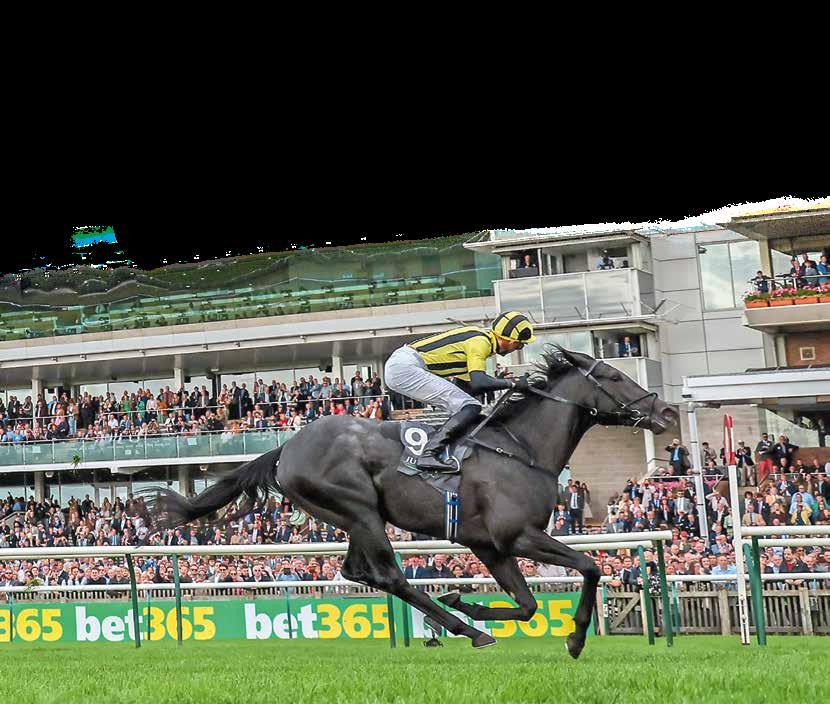
to our own mares. We were initially planning a book of around 150, but he was getting through his covering so well that
Vandeek wins the Middle Park Stakes (G1), his second top level success
Photo: Mark Cranham, focusonracing.com
we extended that to 160.
“Our own mares included the dam of Good Guess, Zykina by Pivotal and Angel Vision, the dam of Berkshire Shadow who won the Coventry Stakes.
“Overall, he got a strong book and we are looking forward to seeing his foals next year.”
In the covering shed, as on the racecourse, performance is everything; Sigsworth and Richardson are more than satisfied with how Vandeek has accomplished his required deeds this spring.
“He has taken to covering well – he was the ultimate professional racehorse, and he has continued in his new role here at the stud,” says Sigsworth. “He is an easy horse to be around the covering yard, and his fertility has been excellent.
“I think he’s put on weight this spring, that is how laid back he is! He enjoys his work and has that great mentality.”
Despite the long relationship with Arrowfield this is the first time that Cheveley Park Stud has sent a stallion to the southern-hemisphere – the Australian-bred Danzero having reverse shuttled to Newmarket from Down Under.
All is in place for a smooth transit.
“He will go into quarantine through the first week in July for a fortnight, and then leave the country around July 18.
“He will be back with us just before Christmas, and will be ready for viewings in the New Year,” outlines Richardson.
“It’ll be an emotional moment for all when he goes, but head stallion handler John Rice travels with him and the pair have built such a strong bond.”
Parting is such sweet sorrow, but the opportunity for the young sire, who was blessed with such speed and bearing the hoped for genetic advantage of Havana Grey, to have early chances in the premier nation of fast stallions, is an opportunity to grasp.
So long Vandeek, see you in 2026!

Heading to the winners’ enclosure after the Middle Park Stakes
Photo: Mark Cranham focusonracing.com
THE CHOICE OF CHAMPIONS

HORSE CARE ULTRA CUBES have had a positive effect on my horses. They look great and are performing fantastically with greater consistency. It is also an extremely palatable feed.
Ed Walker
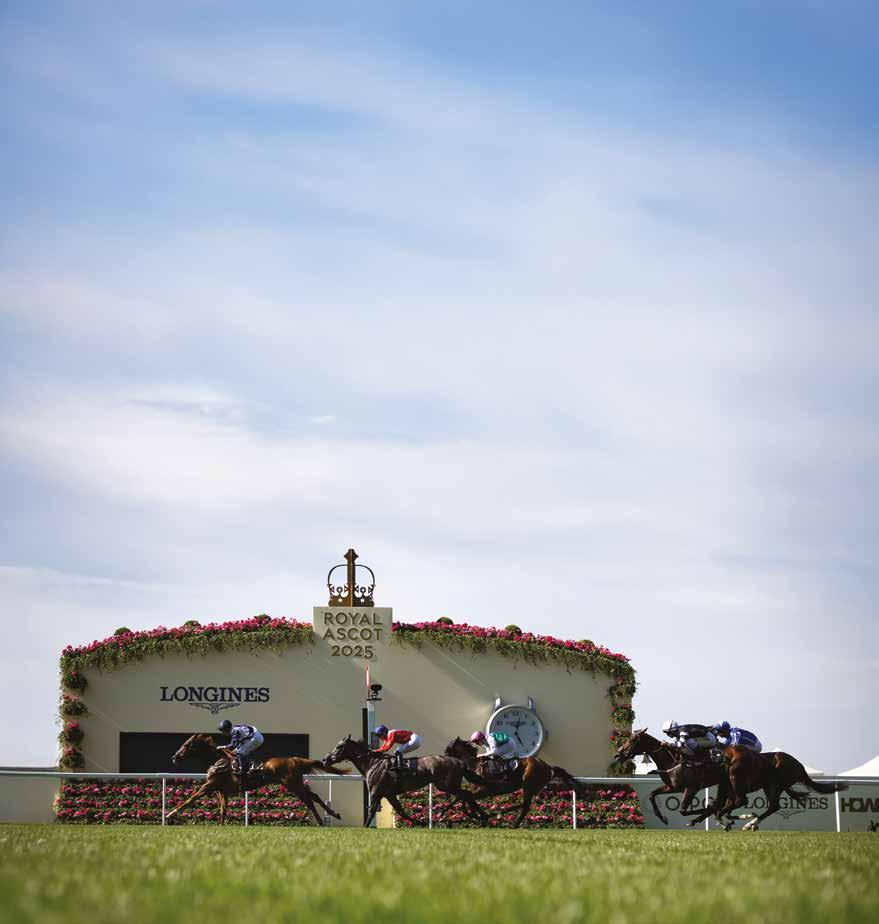


What’s my age again?

The 2005 Epsom Derby has produced two champion sires –the second and third Dubawi and Walk In The Park, both now 23-year-olds, and enjoying a top year, writes Ciaran Doran
WHEN ONE THINKS of the association between music and horseracing, names such as Andrew Lloyd Webber and Emma Banks spring to mind, while one might also be reminded of the names bestowed on certain Coolmore horses by Sue Magnier such as Mozart (Danehill) and Beethoven (Oratorio),
and Bjorn Nielsen’s Stradivarius.
The Californian rock band Blink-182 seems a less likely suitable bedfellow for horseracing; any crossover between the Californian rock band and the racing world would seem accidental at best.
The band was probably not thinking of the Classic crop of 2005 when it composed the lyrics to ‘What’s My Age Again?’:
“Nobody likes you when you’re 23”
is not exactly a quote that would best describe the feelings of breeders in 2025 towards the current champion sires of that age (of different kinds) – the top Flat sire Dubawi (Dubai Millennium) and jumps sire Walk In The Park (Montjeu) with descendants of the pair impressive on the racecourse
Of course, the paths of Walk In the Park and Dubawi did cross on the racecourse when second and the third in
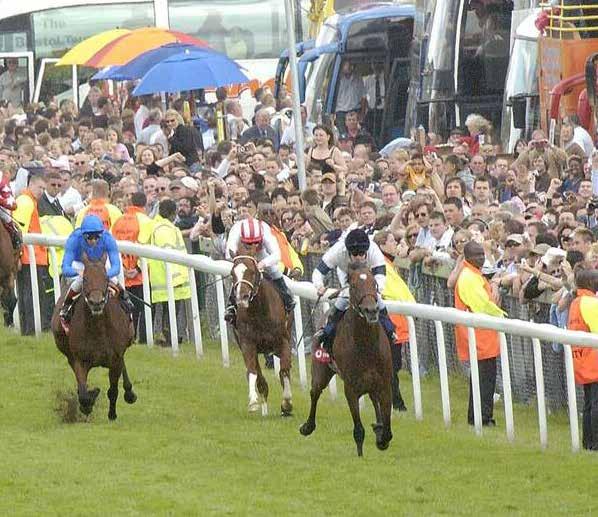
the 2005 Epsom Derby behind Motivator (Montjeu).
At stud, Motivator did not go on to scale the same heights as the other two at stud although he is the sire of the two-time Arc heroine Treve, herself the dam of Doha (Sea The Stars), who won the Kensington Palace Stakes (G2) at Royal Ascot last year before going on to claim Listed success over 1m2f at Saint-Cloud.
Dubawi had previously come home fifth in the 2,000 Guineas behind Footstepsinthesand (Giant’s Causeway), although he made amends by winning a Group 1 at The Curragh for a second time, his subsquent Irish 2,000 Guineas victory accompanying his previous success as a juvenile in the National Stakes.
Godolphin’s Classic success of 2005 was not limited to Dubawi – the 2004
Dewhurst Stakes winner Shamardal (Giant’s Causeway) followed up with victories in the Poule d’Essai des Poulains, the Prix du Jockey-Club (run that year over 1m2f for the first time), and the St. James’s Palace Stakes. The upshot of this is that the five European Group 1s of 2005 restricted to three-year-old colts run between a mile and 1m2f were won by sons of Dubai Millennium and Giant’s Causeway, www.internationalthoroughbred.net 57
Dubawi (light blue) and Walk In The Park (dark blue) in the Epsom Derby of 2005, the race won by Motivator
dubawi and walk in the park

... the five European Group 1s of 2005 restricted to three-year-old colts run between a mile and 1m2f were won by sons of Dubai Millennium and Giant’s Causeway
whose three-year-olds that year were their first-ever Classic crop.
Those performances as sires 20 years ago brought back memories of their performances as racehorses in 2000; Dubai Millennium’s career culminated with a demolition of the Group 1 Prince Of Wales’s field, while Giant’s Causeway won the St. James’s Palace (G1) at the same Royal Ascot in the first of five consecutive Group 1 wins that he won in the space of 81 days.
Dubawi’s success as a sire has, of course, been especially poignant considering he was one of only 56 foals sired by Dubai Millennium, a four-
time Group 1 winner, who claimed the spoils in the Prix Jacques Le Marois, QE II, the Dubai World Cup, and the aforementioned Prince of Wales’s, with his only defeat coming in the form of a ninth-placed effort at Epsom in the Derby.
Dubai Millennium also sired the Group race winner and Group 1-placed Echo Of Light and Group winner Belenus in his one and only crop, and is also the damsire of Decipher (Deep Impact), who was a Group winner in Japan.
A son of Seeking The Gold (a name that makes more sense when you consider his sire was Mr. Prospector),
it was the strength of Dubai Millennium’s female family that was perhaps the most notable aspect of his pedigree.
His dam Colorado Dancer (Shareef Dancer) won the Group 2 Prix de Pomone and the Group 3 Prix Minerve, in addition to coming home third in the Group 1 Prix Vermeille.
But it was his second dam Fall Aspen (Pretense), who steals the show as far as foundation broodmares go.
Winner of the 1978 Grade 1 Matron Stakes in the US, Fall Aspen was dam of the July Cup (G1) winner Hamas (Danzig), the Breeders’ Cup Juvenile (G1) and the Preakness (G1) winner Timber Country (Woodman), the Grade 1 winner Northern Aspen (Northern Dancer), the Group 2 Diadem Stakes winner Bianconi (Danzig), the Group 1-placed Mazzacano (Alleged), and the Group 1 Grand Prix de Paris winner Fort Wood (Sadler’s Wells).
She is also the second dam of the Group 1 July Cup winner Elnadim (Danzig), the Irish 1,000 Guineas winner
Lead Artist (left, pink cap): the Juddmonte Farms-bred four-year-old son of Dubawi winning the Group 1 Lockinge Stakes this spring
... with Trinity College’s Group 3 Royal Ascot win in the Hampton Court Stakes, Dubawi is now the sire of 302 individual stakes winners
Mehthaaf (Nureyev), the Kentucky Derby-placed Prince Of Thieves (Hansel), the Queen Anne Stakes (G1) winner Charnwood Forest (Warning), and the Racing Post Trophy (G1) winner Medaaly (Highest Honor).
And to add further to her laurels, she is the third dam of the Grade 1 winner Occupandiste (Kaldoun), the fourth dam of Grade 1 winner Mondialiste (Galileo), the Oka Sho (G1) winner Reginetta (French Deputy) and this year’s firstseason sire Bangkok (Australia), as well as the fifth dam of the Grade 1 winner Ribchester (Iffraaj) and Prix du JockeyClub (G1) winner Intello (Galileo).
Of course, there is more to Dubawi’s pedigree than just Dubai Millennium.
Dubawi’s own dam Zomaradah (Deploy) won the 1998 Group 1 Oaks d’Italia and was herself a stellar producer; she was also the dam of Group 2 Lancashire Oaks winner Emirates Queen (Street Cry), the Groupplaced Ballymacoll Stud Stakes winner Princess Nada (Barathea), and the Listed-placed pair of UAE King (Frankel) and (Kingmambo).
Dubawi’s second dam Jawaher (Dancing Brave) was not particularly successful as a broodmare outside of Zomaradah and her efforts on the track were somewhat pedestrian.
Dubawi’s third dam High Tern (High Line), however, was more noteworthy; she was the dam of 1998 Derby winner High-Rise (High Estate).
The sire’s fourth dam Sunbittern (Sea Hawk) was also the dam of the Group 1 winner High Hawk (Shirley Heights), the second dam of one of Sheikh Mohammed’s first influential global trotting star performers In The Wings (Sadler’s Wells) and the Group 1 winner Infamy (Shirley Heights).
She is also third dam of 1,000 Guineas winner Virginia Waters (Kingmambo), once again a victory that came in 2005, and the fourth dam of the Group 1 winner and this season’s first-season sire Space Blues (Dubawi), as well as the 2012 Grade 1 Matron Stakes winner Chachamaidee, (Footstepsinthesand), and 2019 Preis der Diana (G1) winner Diamanta (Maxios).
The leading sire in Britain and Ireland for 2022, and with Trinity College’s Group
3 Royal Ascot win in the Hampton Court Stakes, Dubawi is (at the time of writing) the sire of 302 individual stakes winners. His top horses include (**Inhales**) Makfi, Night Of Thunder, Coroebus, Notable Speech, Ezeliya, Zarak, New Bay, Too Darn Hot, Monterosso, Prince Bishop, Postponed, Arabian Queen, Al Kazeem, Coronet, Henry Longfellow, Ghaiyyath, The Revenant, Space Blues, Modern Games, Quorto, and Lord North.
Of course, Dubawi’s success is not exclusively confined to the past and age has not seemingly diminished him; this season his sons have taken out major Group races and he has had two Group 1 winners this year in Lead Artist, winner of the Juddmonte Stakes, and Walk Of
The 23-year-old former champion is, in turn, sire of 10 champions, and 61 Grade or Group 1 winners

dubawi and walk in the park
However, regardless of how old Walk In The Park and Dubawi are, their achievements as sires ensure that their legacies shall be keenly felt for some time yet.
Stars, a Grade 1 Al Maktoum Challenge winner in January.
Dubawi’s enviable legacy also happens to extend beyond his own achievements as a sire of sires; already in 2025 we have seen Night Of Thunder produce a 1,000 Guineas winner and an Epsom Oaks third in Desert Flower, as well as a Prince Of Wales’s Stakes winner in Ombudsman, while New Bay has produced both a Group 2 Dante Stakes winner in Pride Of Arras and a Pretty Polly Stakes (G2) winner in Falakeyah.
The aforementioned Arabian Queen is also dam of the runaway Middleton Stakes (G2) winner and Prince Of Wales’s third-placed See The Fire (Sea The Stars).
Dubawi is likely to remain an enduring presence in pedigrees for years to come, but such was the class of those who tasted Classic success in 2005 that Dubawi is not the only long term Darley sire from 2005 to leave a lasting mark at stud.
The much-missed Shamardal is sire of a fellow Poule d’Essai des Poulains and Prix du Jockey-Club winner in Lope De Vega; the latter, a resident of Ballylinch Stud, who alongside New Bay, has worked his way up the stallion ladder. After starting off at €15,000 he now stands at €175,000 a pop such has been the quality of his progeny (24 Group or Grade 1 winners so far) on the racetrack.
Shamardal is also the sire of three current Darley sires in Blue Point, Earthlight and Pinatubo.
More recently, Shamardal’s son Inisherin won the 2024 Commonwealth Cup (G1) and took out the Duke of York Clipper Stakes (G2) on his seasonal reappearance in May.
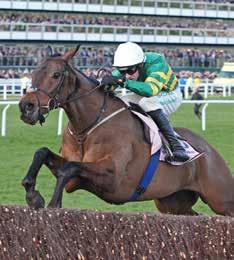
Shamardal’s line has also interacted successfully with Inisherin’s family – Blue Point is the sire of Prix JeanLuc-Lagardère, the Irish 2,000 Guineas, and St. James’s Palace Stakes winner and Queen Anne Stakes (G1) runner-up Rosallion, who shares the same second dam with Inisherin.
This is not the only recent example of a son of Shamardal emulating their sire by working well with a certain equine family – the Group 1 Middle Park Stakes and Dewhurst Stakes (G1) winner Shadow Of Light (Lope De Vega) is the three-quarters brother to Earthlight, a Prix Morny and Middle Park winner.
Shamardal also happened to be the paternal grandsire of this year’s Grade 1 Champion Chase winner Marine Nationale (French Navy) and Blue Point has sired a Grade 2 juvenile winner over hurdles, but, when it comes to NH
success, it is 2005 Derby runner-up Walk In The Park who stands head and shoulders above all other jumps sires.
Now a back-to-back champion British and Irish NH sire, this year with record earnings for a second year, Walk In The Park, bred by the Burns family’s Lodge Park Stud, saw his progeny finish the 2024/25 jumps season with over twice as much prize-money as the progeny of Getaway in second.
The biggest prizes in the jumping game were plundered by his sons Inothewayurthinkin and Nick Rockett winners of the Grade 1 Cheltenham Gold Cup and the Grade 3 Aintree Grand National.
Other big successes were plentiful, too, Jonbon emerged victorious in the Tingle Creek, Clarence House, and Melling Chase, Final Demand won the Nathaniel Lacy and the Alanna Homes Champion Novice Hurdle, while Aurora Vega became the second offspring of Quevega to win a Grade 1.
Given the lengthy time which exists between a jumps sire covering a mare and the resulting foal hitting the track, Walk In The Park still has a lot of likely high-class unraced crops to come in spite of his advancing age.
However, regardless of how old Walk In The Park and Dubawi are, their achievements as sires ensure that their legacies will be felt for some time yet, and especially as Walk In the Park could become a rare NH sire of sires with the current Coolmore plans in place to find him an heir.
Blink-182 wasn’t entirely correct (or at least weren’t correct as far as sires go) with their famous maxim: breeders should really love certain stallions when they’re 23, and age is certainly not diminishing their abilities.
Blink-182 did get one thing right though: given their recent exploits on the track, neither Dubawi nor Walk In The Park seem to be aware that they were born in 2002.
As far as these two sires go, it really is a case of “What’s My Age Again?”.
Walk in The Park’s Gold Cup winner Inothewayurthinkin
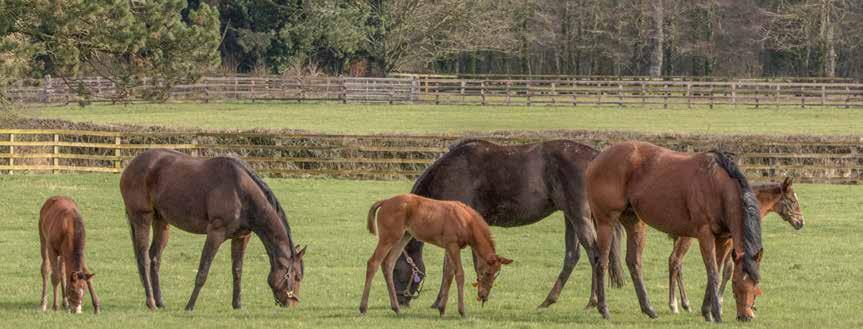
SUBSCRIPTION FEE:
F100 per annum
F50 add. family member
F20 ITBA Next Generation (U30)
SI GN UP TODAY!


Specifically designed Stud Farm Insurance exclusive to ITBA Members
FREE Racecourse Admission
FREE Diary and Calendar
FREE breeding and racing publications
inc digital subscriptions to EBN, The Owner Breeder, International Thoroughbred when a horse you bred is declared to run
Discount Racing TV Subscription
Discount packages with Irish Equine Centre Plus many more...
Greenhills, Kill, Co Kildare www.itba.ie • Tel: 045 877 543 • office@itba.ie




Diversity
Debbie Burt meets artist Terence Gilbert for whom equine art is only one strand of a wide-ranging portfolio from a lifetime of work
FOR NEARLY 40 YEARS artist
Terence Gilbert has been best known in racing circles for his race card montages of famous (and favourite) horses, sold as individual private commissions or popular prints.
However, Gilbert, 78, is far from a one-trick pony and has been producing artwork on a diverse range of subjects and in a range mediums since he was a teenager.
His parents were initially shoemakers in London, and the family lived in a flat near Westminster Bridge and Waterloo Station. His mother worked for several leading ballet shoemakers, Gamba’s and Freed’s with customers including Dame Margot Fonteyn. His father left the industry due to ill health going on to become a civil servant working at the National Gallery
He was an avid punter on his days off work, and the young Gilbert was taken by train to all the London tracks, experiences which would go on to form the basis of Gilbert’s subjects and which continue to this day.
Recalling one of the more exciting
aspects of his formative years Gilbert says, “The area of London in which I grew up had all these illegal bookmakers on the street corners.
“There would be about four of them, but they’d all spread if the police turned up – one would often be up the stairs into our house, which was one of their hideouts!”
Though he enjoyed going racing, Gilbert’s aptitude for art was also present from the start.
He says with a smile, “I was always a favourite of the art teachers at my schools, and with Dad working at the National Gallery, I spent a lot of time there as a boy.”
Even as a young man, he had a fine appreciation of the best artists, which influenced his early work.
“I always admired Turner, Canaletto was a great favourite back then, too –The Stonemason’s Yard I remember as a particularly fine piece.
“As time went on, I started copying them, I’d have been about 13, and I had my easel there at the Gallery, as other artists do, ambitiously starting with big pieces, such as those by Claude Lorrain.

Gilbert in his studio at home


I progressed to doing some illustrations of my own, working for David Judd Associates Limited, which was the top studio of the time that all the big agencies were using
“My teachers got me into Camberwell Art School at a very young age, I was only 15, but everybody else was at least two years older than me, it was terrible!
“Most of the time we were drawing
objects on the floor, as still life, with the idea to get the negative spaces in between the objects and then moving on to figures. It was very limited though, not full time.”
Sadly, tragedy hit the Gilbert family and he lost his father when he was just 16, it meant young Gilbert had to head out and earn a living.
“I began in advertising as a junior and, as I knew London like the back of my hand, I was the delivery boy, delivering to ad agencies and to print works, which gave me a knowledge of how these businesses operated from the ground up.
“I then started in the agency studio itself, drawing keylines for brochures, Royal Ascot
there were no computers then, of course. The page layouts were all done by pasting photographs and getting things down on boards and in shape.
“Luckily, I was sat next to some of the great illustrators of the time – Renato Fratini, Gino D’Achille, Pino Dell’Orco. The Italians were here in London and, luckily, I was in the thick of it – Fratini did the James Bond poster for From Russia With Love.
“I progressed to doing some illustrations of my own working for David Judd Associates Limited, which was the top studio of the time and the one that all the big agencies were using, such as J Walter Thompson and Rubicon.
“They used David Judd as it was the crème de la crème with all the best artists – as advertising agencies didn’t have any creative staff to do the illustrations, or lettering for instance.”
It was time well spent for the young man who learned the techniques of commercial illustration.
In 1966, at just 19, he decided to branch out alone.
“I had a few contacts, and I started doing illustrations for magazines. All the magazines then, such as Women’s Own, they all used illustrations so there was plenty of work, Canada Dry was another client, and from there I slowly moved things along.”
He moved out of London to Maidenhead in 1969, which, for the born and bred Londoner was something of a shock to the system at first and he remembers that it was “too quiet for me, but London was too noisy for my wife!”
He made a studio from an upstairs bedroom, and has worked from the room on an almost daily basis ever since.
In those early days, book cover illustrations were the bill payers, the rise of popular pulp fiction offering plenty of work and his commissions would come by consignments.
“One day it was 18th century romantic novels by Georgette Heyer, the next it would be World War II, such as Cornelius Ryan’s The Longest Day,” he recalls.
All the magazines then, such as Women’s Own, they all used illustrations so there was plenty of work, Canada Dry was another client, and from there I slowly moved things along
An American company suggested he try westerns, which led to a steady income stream, both for the book covers and selling the original artwork through the Stremmel Gallery in the US, and Gilbert subsequently developed a strong following stateside, too.
Early work as an illustrator
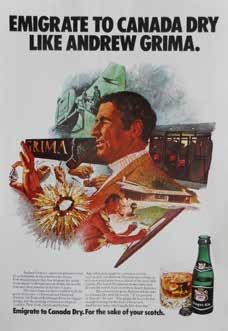
His subject matter took a different turn in the mid-70s.
“My wife [a court room journalist] saw an article about the arms dealer Adnan Khashoggi, and it mentioned a collection of art that he’d bought from the Mathaf Gallery in London. I contacted them just at the right time, as they were looking for an artist to go to out to the Middle East.
“They chose me and I went out to there to paint, I was with them for about five years.
“Back then it had been a taboo thing so no one had painted these countries, all the earlier Orientalist painters had gone to Egypt or Turkey, so it meant that I was one of the first to paint in the region.
“I would put together at least four or five paintings for Oman each year, as well as portraits of Sheikh Zayed and other Emirati rulers, and some of old Dubai before it was developed for Sheikh Mohammed Al Maktoum.
“The western works were also going well then and I’d also started to do some racing, the montages on the racecards.
“The Middle East market slowly waned, of course, it’s full of artists out there now. Luckily I have other strings to my bow, such as the racehorse.”
He reflects, “Now I can just jog along, I’m not fighting to find the next commission, though one always needs money, I can do whatever comes up.”
As his work became known on the racing circuit, he began to pick up some fine commissions.
“I got to know some trainers, mostly in Ireland. I knew Peter O’Sullevan very well and he introduced me to John Magnier.
“I went over to Coolmore to paint his horses, including Galileo, and I did about four big paintings of the Queen’s visit in 2011. I also painted Yeats, and later I did another of Galileo racing.
“Most of the work I do in Ireland now is for JP McManus, the last one for him was I Am Maximus.”
Another notable equine commission

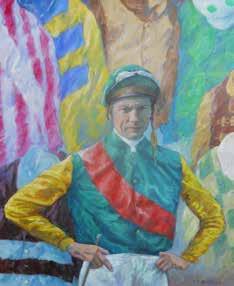
If you can draw and paint in illustration, you’ll get assignments in everything, you can either do it or you can’t
in the traditional style was of the late Queen riding with Ronald Reagan in Windsor Great Park, which was presented to the President in the White House.
One of his biggest sales to date was the £27,000 paid for a portrait of Lester Piggott with his all Derby-winning silks behind him, an auction piece for the Sir Peter O’Sullevan Charitable Trust.
It’s a charity close to Gilbert’s heart and he already has another piece underway on the easel ahead of this year’s event.
Gilbert’s work spans an incredible variety of mediums, techniques and subject matter, and he credits his early
commercial artist beginnings for his diversity.
“I was always very good at figures in action – whether it was a gunslinger, or a German officer firing a machine gun. To me the figure is the main thing, dressing just goes on the top, it just developed.
“If you can draw and paint in illustration, you’ll get assignments in everything; you can either do it or you can’t,” he explains, adding: “It was the variety of subjects in illustration that led me to paint everything.”
Of his choice of medium, again he has never been opposed to new ideas.
“I’ve always worked in all mediums, pastels, pen and ink, acrylics, oils, anything. With illustrations everything always had to be done tomorrow, which meant that I used gouache a lot for pictures. I make them look like oils, but by using gouache it dries very quickly.
“These days, primarily I use acrylic first and then oils on top, so I don’t have to wait too long for the under-painting to dry.
“I’m doing a lot more canvas painting now, but illustrations were always on board. I loved Edward Seago’s work, he
always painted on hardboard, gessoed on the top, so that’s my preferred medium as I like to use a painting knife.
“With a knife I can scrape in because it’s hard, then add colour, but on canvas you can’t, as it gives too much. I’ve got more impressionistic with some of my work in recent years and the colours are very high key. My latest is of the paddock at Ascot, which is proving a very popular print.”
The commercial background has still not left his heart.
“I work mostly on a 20 x 24 inch ratio, but because of my commercial background, I never really have a strong preference to do what I want to do, it’s always whatever the client wants.
“I get bored with things quite quickly, so after I’ve done a few of the racecard montages, then I want to change and do something else.”
The “something else” also extends to London cityscapes, including haunts from his youth such as the Old Vic and Westminster Bridge, scenes from the ballet, where he has sat and sketched in the audience, and his love of Jazz at Ronnie Scott’s.
His sporting interests are not just
Frankel
Lester Piggott
confined to racing, and he has had commissions to paint England Rugby fly-half Johnny Wilkinson, Manchester United’s David Beckham, Ryan Giggs and Ole Gunnar Solskjær and once, at very short notice, the Tyson Bruno fight. Then he took his reference off the television and dried the finished piece with a hair dryer!
He also attends the Henley Regatta every year producing a collection of cartoon characters, usually a sell out.
Retuning to equestrianism, he observes: “I do like to do the whole horse in a landscape. I painted Generous at Paul Cole’s and Nashwan for Sheikh Hamdan at East Ilsley.
“These days I find traditional types of painting a bit flat, and there are so many people producing them, you try to do something different, I don’t want it to look like a photograph. A painting allows you to add information that might not be easily seen in a photograph, which then adds narrative.”
These days I find these traditional types of painting a bit flat, and there are so many people producing them, you try to do something different, I don’t want it to look like a photograph

Even today, after a lifetime of work, his style is still altering and developing, and was the basis for the Tattersalls parade ring picture used on this magazine’s December 2024 front cover.
“I’ve moved to this impressionistic style, reminiscent of Raoul Dufy, but my

own interpretation,” he explains.
“I’ve done about 30 of those larger pictures of paddock and racecourse scenes at York, Cheltenham and Ascot.
“From a commercial aspect those horses on the racecards, they’re very easy to personalise, whether you’re an owner, a trainer or a punter that won big – the racecard adds a bit of authority to the piece, it’s a record of the day.
“I like to add little jots on there about the trainer and so on, so it feels like it’s been painted on the spot.”
Gilbert’s studio is crammed with old exhibition catalogues and work at various stages of completion, though he does admit to one very interesting fact.
“I used to be an Elvis impersonator! I used to go to auditions with my guitar, I called myself ‘Chad Martin’ and they used to say, ‘Chad – can we call you Terry? Tell me, how are the paintings doing?’
“They knew I painted as well and they were obviously telling me I should l keep on with that instead!”
It was a decision that has served him well, as he concludes, “I know artists specialise in one subject and they get known for that, but on the other hand because I’m so diverse, I’m never out of work!”
Piccadilly Circus
Our December 2024 front cover featured Gilbert’s image of the Tattersalls sale ring
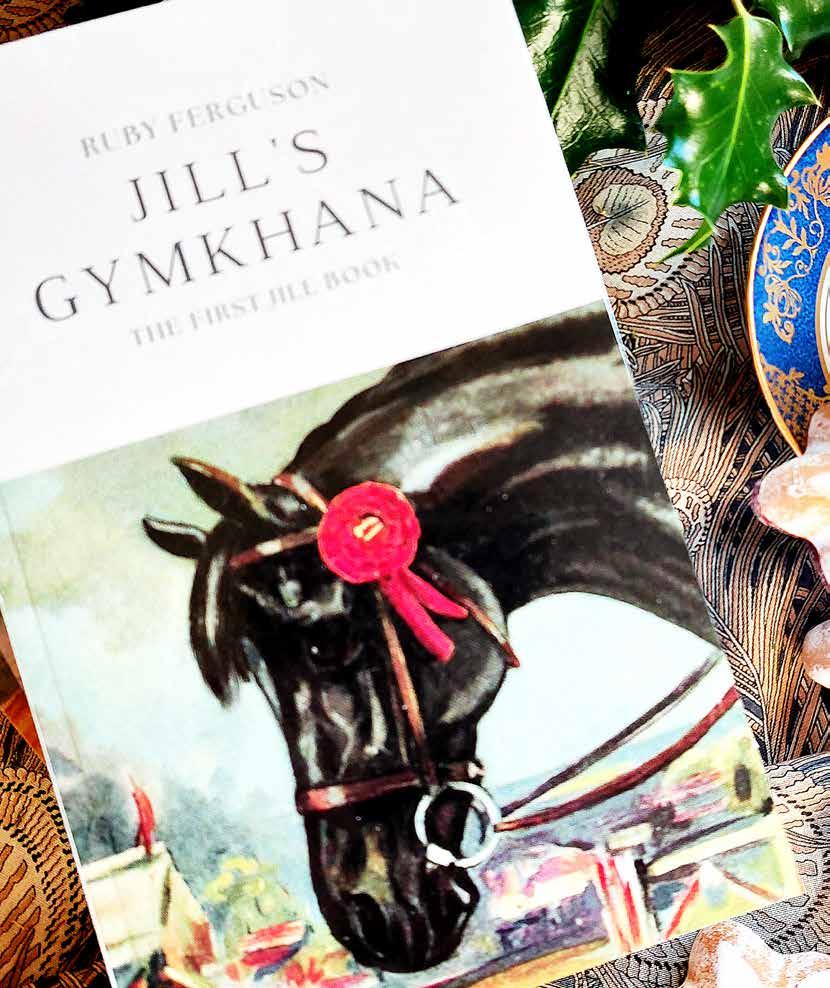

ponyTurning books into ebooks
Jane Badger is making the most of new technology to bring back life to pony books that through the 1950s-1980s was a whole literary genre of its own
FOR WOMEN now of a certain age, and who had a teenage passion for all things equestrian, growing up in the post-war period through to the 1980s involved reading pony fiction.
In a gender split, that would not be deemed correct in today’s wokeinfluenced creative world, these books were not really targeted at boys, the audience largely young females often without ponies of their own but who had a raging desire to be horse owners.
The books often featured brave heroines who overcame life obstacles to achieve their equine dreams, or who used their equestrian prowess, and, of course, the willingness of the loyal ponies, to battle against nasty
wrongdoers in equine versions of the Famous Five
The girls showcased in the books were strong young females more than able to do the same as boys, and who certainly did not see gender as an obstacle.
Many women who have since gone on to achieve so much, and have been groundbreaking in the worlds of horseracing, showjumping, eventing and general equestrian pursuits, would have been heavily influenced by the books.
It was a genre all of its own with numerous books written by the likes of Christine and Josephine PulleinThompson, Ruby Ferguson, Patricia Leitch, Monica Edwards – names that many women of a certain age will certainly be more than familiar with.
These books, some now written over

Jane Badger (left): made the most of skills developed to help her godfather to start her ebook pony publishing business
60 years ago, could have been lost to the writing world if it were not for Jane Badger whose business Jane Badger Books is passionate about rekindling the genre.
Badger is successfully combining the advantages of today’s technology with old-fashioned creative, recreating books and stories allowing the books to find second lives as ebooks or as short-run prints.
With a degree in ancient history and previously with a successful career as a software advisor and trainer, Badger started proofreading and writing training manuals for the Royal Mail before a move out of London led to her selling second-hand books.
“I bought some pony books that I’d read as a child, when I saw them I thought, ‘I remember those!’ They were beautiful, lovely first editions, but, despite buying them, I decided I not really want to keep them so sold them ebay,” she recalls.
“That went really well, and it sort of took off from there. I did that for a few years, my specialty was everything equine, and I pulled together my website off the back of that.”
From that outlet, Badger wrote her own book Heroines On Horseback, an academic publication analysing why the pony book had such an enduring passion and the role the genre has played in young lives.
BADGER’S second-hand book selling came to an end as profit became more difficult to find in a tightening market place, leading her back to a freelance proofreading role, which had been something of a side hustle for the soon-to-become publisher.
“The publishing then sort of came about almost by accident – author Patricia Leitch’s heirs had inherited her literary rights, and had asked me a couple of years before if I knew of anyone who would publish the books.
“I gave some suggestions, things that they could try, none of which worked. They come back to me again, asking if I could think of anything else because they’d wanted to get the books back.”
As with many good entrepreneurial ideas a germ of an idea developed, and in tandem and almost by accident; Badger started thinking outside the box.
“I had bought a John Buchan for my godfather,

a shooting and fishing novel set in the Highlands,” she recalls. “Again it was a first edition, but when he rang it to say thank you, I realised that he could not see it!
“He was using a Kindle then and he had a magnifying glass to read. So I decided to try and scan the text and see if I could make it into an ebook for him. Eventually I worked out how to do it, but by the time I’d done it he’d read the book –he never did get to use my long worked-on file!”
Undertaking that not inconsiderable process to develop a new skill set, led to Badger to her light bulb moment.
“I finished doing the Buchan, I thought, why don’t I take this knowledge I have laboriously acquired and see if Leitch’s heirs would be interested if I did the same for them?
“They were keen, despite the fact that I was starting from absolute scratch!
“I was by then a member of the Society Of Authors, so I worked with them on a contract –I like to think that my contracts are fair to the authors as well as to me, and designed so we can both get out of it if we want to, it can be renegotiated rather than just go on.”
Dream Of Fair Horses was published in 2018 as
I like to think that my contracts are fair to the authors as well as to me, and designed so can both get out of it if we want to
Dream Of Fair Horses was the first for Jane Badger Books. There are now over 100 publications listed as published by the company
There are obvious things I will correct, for instance in one book the name of a character was changed halfway through, and quite often horses can change colour!
the first ebook for Jane Badger Books, initiating a whole new niche for Badger to explore – in the short time frame since her book empire has already developed to quite the collection with over 100 books under the banner.
“I found Christine Pullein-Thompson’s agent, and they were happy for me to progress, which gave us some more impetus. Since then it has been a combination of approaching authors myself, while some have also got in touch with me direct, too.”
To establish the books as an ebook is quite a process. First, Badger must find families and relations to authors and the rights holders, which gives Badger some detective work, she uses online sources such as ancestry.com, as well as contacts and business links.
Badger must then get permissions, rights, contracts and legals in place. Then she must access a first edition, which is physically scanned using an optical character recognition technology machine in her own office.
The text is proofread by her, proofread by freelancers, formatted, the front cover artwork is decided upon (often the copyright regarding original artwork is unable to be resolved) before the final production turns the words into a digital publication.

Through the process some limited editing takes place, in agreement with the families, with items and phrases tweaked.
The publisher tries to keep any change to a minimum, and trigger warnings are placed at the front of the publication regarding content that might not be part of today’s society.
“I try and do as little as possible,” she says, before laughing: “There are obvious things I will correct, for instance in one book the name of a character was changed halfway through, and quite often horses can change colour!
“If the author is still alive I will speak with him or her, but often it
will be chat to find out what the family wants to do.”
Badger will finish the process by producing the book in a paperback version, and then, hopefully, all involved go on to be online winners - including the bookkeepers!
“I think the various authors’ accountants are quite happy that these books are becoming digitised!” laughs the publisher
Getting the books marketed and sold is largely done by social media and world of mouth, alongside her own recommendations and an email database.
Although the books are listed on Amazon, most sales take place via janebadgerbooks.co.uk with the publisher keen to limit her reliance on the global monolith operation.
As she has come to the world of publishing by the digital world, a very different path to many publishers who started life in a world of print and reliant on getting their publications in to book shops, it has meant that her company is not dependent on the big print distributors and subject to the whims of their demands and commission charges.
It is a perfect case scenario for niche, indie publishing.
Yet, if anyone reading believes this is just a passion project for a middle-aged lady to relive the dreams of her youth, they would be very much mistaken, profit is very much the beating heart of this operation.
“I’ve always had to make money, I can’t do this just because I want to, the aim has always been to make a profit,” she rationalises. “I have always done so, and that’s always governed how I’ve approached things.”
With short runs and print-on-demand services also now available, if her buyers still wish to read in print they can order one book direct from her site, with a direct order going to the printer.
She is finding the split for digital against print being around two-thirds ebooks and one-third print.
There is one overarching and determining factor regarding the books chosen for epublishing – Badger must like the story.
“I have to work really hard to sell the books, and I would not be able to so if I didn’t have enough buy-in to the story,” she says.
“Obviously I like some more than others of them, but I invest so much into the each book that
I need to be able to sell honestly and recommend each book, and know why people might like it, too.
“With businesses such as mine dependent on social media and word of mouth, you are selling yourself, as well.”
WITH THAT commercial head
Badger certainly does not find herself regressing to her childhood and drifting away to her teenage years when reading the books.
“Writing Heroines On Horseback required me to distance myself; I actually had to come up with some literary criticism rather than just going, ‘Oh, it’s lovely’.
“I tried to find the answer as why these books speak to people, and why do they still do. Why is the genre important? How did it fit in the children’s literary scene at the time?
“They were interesting concepts to understand, and it did give me that little bit of distance.”
There is, of course, a very well-defined demographic for Badger’s consumers, and for whom rediscovering a lost youth is very much the reason for purchase.
“Customers are really the 40-year-old plus female,” she says, “wishing to revisit their younger years, or buying for younger family members.”
Despite her now extensive ebook knowledge, thoughts to expand the business into books away from the equine and pony niche is not something contemplated by Badger.
“It would be difficult,” she says. “We did do a couple of cat books when my daughter was here during COVID and, while it sort of fitted in, it didn’t either. Moving into different fields takes the focus away from the marketing of the main job; it is so much easier if you’re just concentrating on one thing.”
Seemingly the desire for girls to ride ponies is as strong as ever, but is reading pony books and pony writing still a thing?
“Pony fiction does still exist, but tends to be more of the self-published variety today,” explains the publisher.
“There is an appetite out there, but it is different now and how people of my generation
got access to horses is quite different to how children do now.
“For us, there was obviously physical access – you went to the stables and you got other horsey information from pony magazines, newspapers –I used to cut out photos from the racing section in my parents’ paper – and pony books, and that was really pretty much it.
“Now with the internet and social media, it is different for children – for instance, there are several child influencers on Instagram with 1000s of followers and I think children live through them, or see themselves in them, rather than pony books.

“The influencers do write pony books, which sort of reinforces that, too. I am also not sure those reading the material need to find that sort of equine contact, in the same way that you would have done pre-internet age,” she says before summarising, “Children just do consume very differently now.”
A quick flick through Instagram to find pony influencers reveals one account called @ponynuts with 152,000 followers.
It is a figure which puts British racing’s names to shame - for instance, British jockey Tom Marquand, one of the sport’s most high-profile on the platform, has only 33,000 followers.
In this ever-progessing digital world with social media such a dual-headed beast, it is refreshing to meet Badger whose business harnesses the best of new technology to take us back to perhaps more straightforward times when all a child needed was a well-loved pony and a good pony book
, Now, with internet and social media, it is different for children – there are several child influencers on Instagram with 1000s of followers

Jewels in the Crown
The new Crown Jewels Racing broadcasting joint-venture between Racing TV and HBA Media is a bright light in global horseracing
Tom Stanley and Ally Vance presenting for Crown Jewels Racing at Ascot

GLOBAL RACING is undoubtedly a current success story. Just a look at returns from bloodstock sales over the last three years shows that horses with global appeal either by pedigree or performance attract a premium price, with global buyers or their agents willing to travel the world to purchase horses who could then take them on racing trips around the world.
Arguably, the huge prize-money pots on offer in certain parts of the racing world have contributed to this demand, but the rise of international racing coverage on the TV channels has certainly helped fuel this desire, too. Global sports viewers become more aware of the sport, and the sporting and lifestyle attractions that it offers to all.
Racecourse Media Group (RMG) with its established domestic and international coverage, and the horseracing media rights company HBA Media (HBA), have individually long been involved in getting global racing onto our TV screens, but in 2024 the two companies came together to form Crown Jewels Racing (CJR), a concept to sell a package of global racing to international television distributors.
Seb Vance, RMG’s director of communications and international TV distribution, explained how the project came to life.
“RMG manages the full media rights for 35 British racecourses, as well as TV distribution rights for Ireland, Dubai and Bahrain,” says Vance. “RMG has a strong portfolio of racing, which we distributed to predominately racing broadcasters around the world, however it was difficult to sell and market to a wider audience, given the one-off nature of many events.
“Sometimes broadcasters could be interested in two or three races in the year, we would get them on board, the race would happen and then that would be the end of our relationship until the next event, which could be months later. There was no real marketing from one event to another, and no narrative as such. It was
difficult to retain broadcasters’ interest.”
He adds: “When selling our rights, we were going up against HBA, and as we were the only two real players in town, it made sense to talk.”
A first move was made by RMG which recruited HBA as its own global distribution agency and then, just over a year ago, the new CJR concept emerged building on that early relationship.
“We have created a portfolio called Crown Jewels Racing. The package includes 20 international races, and as the name might suggest, features the majority of the biggest races from around the world ranging from the Middle East in the spring to the Far East in the late autumn, moving across Europe and through the US and Australia along the way,” outlines Vance.
HBA has a long history of involvement and business with international racing. The company was founded in 2006 by Henry Birtles and in 2010 signed with Victoria Racing Club and the Breeders’ Cup to manage the international non-betting broadcast rights for their blue riband events - the Melbourne Cup Carnival and the Breeders’ Cup World Championships.
The Pegasus World Cup was added to HBA’s portfolio in 2017, the Saudi Cup in 2019 and then a four-year deal with Ascot Racecourse for their entire international rights portfolio, including the Royal Meeting. This was renewed in 2023.
The company now represents the rights of renowned races from the UK, US, Australia, Saudi Arabia, UAE, Japan, France, Italy, Germany, South Africa and Hong Kong - working closely with federations, the racecourses and the world’s major sports broadcasters to grow audiences and commercial returns.
HBA Media’s CEO, Frank Sale, says, “HBA was born out of the UAE and the Dubai Racing Channel and that created a successful bedrock for the business.
“Now Crown Jewels Racing offers a whole package that is of interest to broader outlets, away from dedicated racing channels.”
The goal is to spread the racing word and the project has been hugely successful

We have created a portfolio called Crown Jewels Racing, and the package includes 20 international races and, as the name might suggest, it features the majority of the biggest races from around the world
The CJR production team in action taking the feed from Dubai and turning it into television

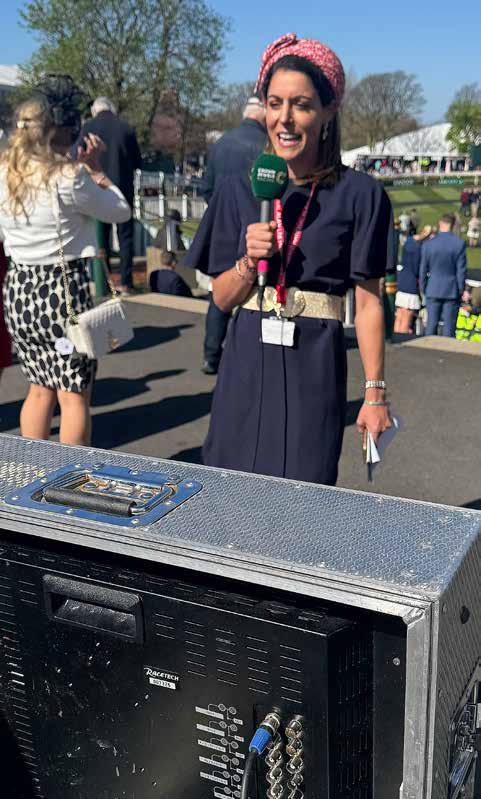
Broadcaster Ally Vance: the shows have consistent and high-end production, which has helped establish and secure the CJR brand
in that regard, consistently getting 30 broadcasters airing CJR races in 140 countries. The content is emerging from the shadows of the dedicated racing channels into the bigger, wider-ranging and influential sports shows.
As Sale continues, “Six to seven years ago distribution of our key events for both businesses was going to racing channels around the world, with a handful of sports channels. Following the advent of CJR, the best races are now being viewed in the mainstream alongside other tier one sports properties. That had never happened historically.
“Our goal is to expand reach and increase revenues for our racecourses and racing clubs. The package we’ve put together as ‘the best of the best’ has allowed broadcasters to promote one brand and tell one narrative, rather than 20 stand-alone events.”
THIS ONE-STOP SHOP has allowed the team to create a strong brand, that can be cross-promoted and pre-sold as one package across the whole year and across the globe. There is also now a consistency of production with bespoke-designed titles and graphics, helping to create a wellregarded and distinctive brand.
That continuity of message that CJR provides is appreciated by broadcasters.
“They are now hearing from us week in week out,” outlines Vance, “whereas in the past they might have contact with us in June, July and then we wouldn’t talk again until the following year.
“So, we’ve got that constant dialogue which really helps and what is really encouraging is that some broadcasters, like ESPN, who have signed up to the CJR’s 20 events, have signalled that they want more races away from the top days, and some who might have been taking only a
handful of races are interested in signing for the whole 20.”
“It’s a powerful narrative month-tomonth throughout the year. It’s easy for broadcasters to schedule in and the dial is moving commercially, there’s no doubt about that,” says Sale.
“We’ve expanded into new streaming platforms and we are seeing strong viewing figures, which are growing alongside rights fees.”
CJR really is something of a success story within both the racing world and the broader sporting landscape.
“Most markers are currently trending downwards in terms of sports rights fees,” adds Sale. “We are bucking that trend, and seeing rights fees grow yearon-year and being able to pass that back to our partners is really positive.”
The similarities of CJR and other major sports are obvious – a global, fast-moving sport spanning the globe with events held at glamorous and wonderful locations with many of the uber-rich and famous involved, correspondingly the production includes lifestyle and entertainment sections allowing viewers a tantalising glance at just what the sport offers.
As Vance says, “You get this amazing splash of colour in Florida for the Pegasus World Cup in January, watching all the celebrities enjoying the racing, drinking cocktails, and then you move to Saudi Cup the following month and you get a peek at what Saudi life is like, and then on to Dubai for the big desert party there.
“We then move to the pageantry of Epsom and Ascot, the garden party atmosphere of Goodwood, and then on to York, which stages the Juddmonte International, the race ranked by Longines’ ratings as the world’s best last year. There’s fashion, there’s food, there’s
fun - it portrays what a great spectacle racing can be.”
However, the difference of scale with other sports is also important.
“We can’t be compared to tier one sports, such as Premier League Football,” outlines Vance, adding: “Deals just don’t land in our laps when it comes to horse racing. We do have to go out there and market really hard, something, which collaboratively we’re now good at.”
WHAT HAS BEEN important to the project was fan engagement and the development of the free-to-enter online Crown Jewels Fantasy game, a straightforward “pick and you win” digital game.
It is not allied to a betting product nor have any links to betting, which is vitally important bearing in mind that many countries receiving the coverage do not allow betting or that betting on horseracing is not an important part of their country’s fabric.
“Crown Jewels Racing Fantasy was built in partnership between HBA and Genius Sports – the leading company for building free-to-play online games,” outlines Sale. “It runs alongside all 20 races and is an engagement tool for the broadcasters and their platforms allowing them to promote to their audiences. It’s easy to play, it’s very simple – players just need to pick three horses, and it is popular.
“Crown Jewels Fantasy is one of the only online racing games without links to betting. And again, that is quite a refreshing offering for broadcasters and global audiences, many who don’t have a
Crown Jewels Fantasy is one of the only online racing games without links to betting
great knowledge of betting. The game is certainly something is that more open to the mainstream audience, with it being aesthetically pleasing and simple to play.”
Of course, within usage restrictions, the data that could emanate from the game could prove to be strategic and beneficial to the various commercial parties involved.
World Pool has become such an important part of the international betting and financial backing, and while races featured as part of CJR are obviously shown as part of the World Pool, there are no direct links between CJR and the global betting project.
However, the greater coverage has certainly led to growth in global eyeballs on screens and that can have nothing but a positive effect on the betting world. The unprecedented TV coverage for the Dubai World Cup in March, garnered by RMG and BHA, contributed to record World Pool betting turnover.
The TV exposure didn’t go unnoticed by His Highness Sheikh Mohammed, Ruler of Dubai, who posted on X how the event was, “broadcast live to over 170 countries”
The sport is now being broadcast in countries, which hitherto had no real racing heritage, while there are growing and developing associations with countries who have a longer history with the sport such as India and Japan and are looking for its racing industries and its outlets to grow.
And with the ever-growing development of streaming platforms, and the digital world being a natural platform for live sport, the future is still very much on film – whether that be on a traditional TV set, via a computer or a digital device.
And while CJR is a commercial venture set up between two companies who have taken what they are good at doing, made it bigger with a view to being better; global horseracing is the ultimate beneficiary.
The sport is now successfully marketed to the world, for once horseracing has been able to come together under one brand to reap the rewards of a successful joint venture.
Crown Jewels Racing is shining bright.

Fact-based nutrition
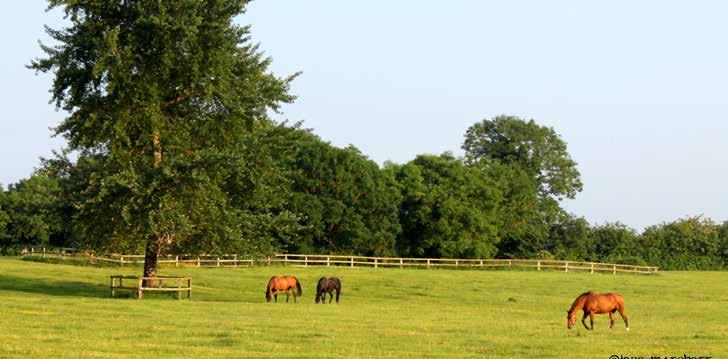
GRASS, WATER, WINTER
FORAGE, compound feed, balancers and supplements all play a role in equine nutrition. Grassland management and equine nutrition are intrinsically linked. The better you understand your grass and nutrient profile of your grass - the less additives you add.
To fulfil their potential, horses require balanced feed rations delivering optimal nutrients all year round. Ideally grass rations will supply the majority of what our world-class bloodstock requires in all phases of life from reproduction, growth and development through to athletic performance.
Species variety is essential to a pasture and optimisation of your horse’s long-term
health, including a mixture of natural herbs and legumes in your grass mixture will increase nutrient availability in the grass and ultimately the diet of your horse.
As well as grass nutrition, knowing the nutritional and mineral values of your hay is essential. During winter and early spring, when grass levels are low, hay or haylage can make up to between 40-60 per cent of your horses diet. In that case the difference between six per cent protein and 10 per cent protein is huge. This can have a big impact when your foal becomes a yearling.
Analysis & Soil Mapping
Analysis is the key to knowing, not guessing, what your farm’s quantities are and taking chances from one year to the next.
In this month’s ITBA report, the team discusses the importance of soil knowledge as a vital component for the delivery of top level nutrition to your horses
Certain nutrients can be toxic when over supplemented. For instance, many areas in Ireland can be high in selenium, therefore supplementing on top of that can lead to problems.
Close analysis of the soil, antagonistic nutrients, pH and other external factors all play a huge role in knowing which parts of your land need added nutrients at specific times of the year.
Keeping records and monitoring results can allow you to see an increase in optimal levels and a reduction in negative issues.
You can predict issues, and this allows you to react quicker when you know what your land is likely to do throughout the year.
The aim is to produce top quality horses who are sound, have good limbs and as few deformations as possible.
We want to make sure the soil is in the best condition possible to grow the grass, and when you have the grass, you want to know its whole nutritional make up so you can make the best decisions.
Indiscriminate fertiliser application to drive grass growth and over-supplementation of feed for horses is not just environmentally unfriendly; it is inaccurate, unhealthy, inefficient and a waste of money and resources.
Analysis can allow you to map your farm, showing the level for each nutrient.
On the right, is an example from the Irish Equine Centre for Phosphorus, with green at adequate levels, red at excess and yellow/orange at low.
You can use the maps to target where to increase organic matter/bagged fertiliser on your farm.
Financial sense
Example analysis of Farm A from the Irish Equine Centr
It is a 100-acre farm, has not soil sampled for some years.
In the past the farm has habitually been fertilised with one bag per acre, twice a year.
• 200 x 50kg bags = 10,000kg or 10 tonnes
• 10 tonnes @ €560 per tonne applied = €5,600
2025 Plan
• Soil Sampled: 10 samples @ €36.50 per sample = €365
• Following sampling
it was advised that the farm needed aeration everywhere and organic matter was applied to 25 acres.
• The cost for this was €1,000
• Lime applications on 30 acres where the pH was low @ 1 tonne per acre = €960
• Fertiliser required on 35 acres of summer paddocks @50kg per acre = €980
• Total costs for the 2025 plan was €3,305.
• The total savings made = €2,295
The big advantage is that it is environmentally sustainable and biodiversity friendly. This provided healthier soil with much better soil microbiology and better grass growth.
Stud Farm Land Assessment Package
The ITBA has a subsidised Stud Farm Land Assessment Package with the Irish Equine Centre for €150+VAT for its members (full price €340+VAT).
This comprehensive package includes soil analysis, water testing and grass sampling to allow you to see the full nutrient
picture of your farm.
Analysis covers a nutritional and mineral analysis of your grass, P, K, pH and lime requirement of several soil samples and a bacteria and physiochemical analysis of a water sample.
The samples will be taken by a member of the Irish Equine Centre staff with a turnaround of 10 days.
For full details on the Stud Farm Land Assessment Package contact the Irish Equine Centre on 045-866 266 or email: nutrition@ irishequinecentre.ie.
Book directly quoting your ITBA membership number.

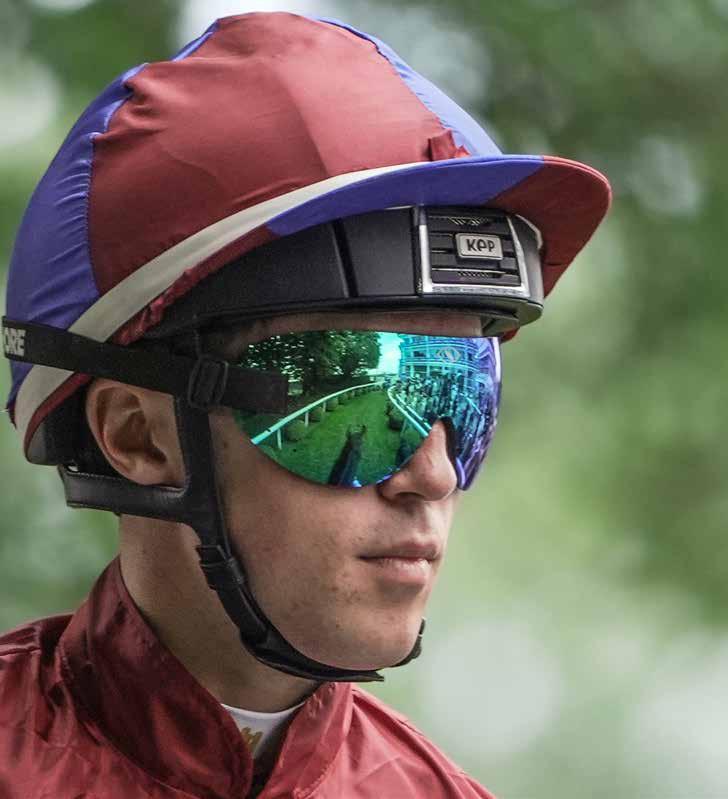
Dylan Browne McMonagle looks ahead to his ride in the Epsom Derby... the jockey heading down the chute from the parade ring on Tennesse Stud, the son
In Browne McMonagle’s reflective googles, we get our own birds’ eye view of the sight ahead and his horse underneath him, riding along with the 22-year-old Irish jockey. He was taking part in his second Epsom Derby having finished sixth in the 2024 renewal on Dancing Gemini
Tennessee Stud went on to finish third, staying on well. The Annemarie O’Brien-bred colt will have probably run in the Group 1 Irish Derby by the time you read this.
of Wootton Bassett.
Photo by Debbie Burt















































